
 |
![]()
Washington Women's Rowing
History
|
Welcome to the Washington Women's Rowing History! Our goal is to continue to add to this collection with more photos, videos, interviews, links and stories over the coming years... if you have any photos or media that would strengthen or augment this history, please email them to webdev (at) huskycrew.org. Thank you! A note to our readers: From the beginning in 2003, this history project was built for the web - with the flexibility to add new material (this entire women's collection was written and added as a celebration of the 50th Anniversary of Title IX in 2022), and the ability to include audio and video - and continues as one of the only consistently updated, extensively detailed collegiate sports history collections, across all sports, in the world. The downside to publishing on the web is the ease to which material can be used without consent. Please respect the effort and time that our authors, photographers, and contributors have put into this body of work, and if using any material published here, please contact us first. This men's and women's combined collection - 600+ written pages with over 7,000 photos - uses Microsoft Frontpage, a software that was developed before smartphones. Moving the content now is financially prohibitive; but even if we did have the resources to do it, we would much prefer those resources go to support the current teams! So the best viewing experience of this history is still by laptop or desktop computer (or tablet). All written and audio content on this page, unless otherwise noted, are copyrighted and written by Eric Cohen. For questions, comments, or history additions, please contact us at: webdev (at) huskycrew.org. Thank you.
|
||||||||||||||
|
||||||||||||||
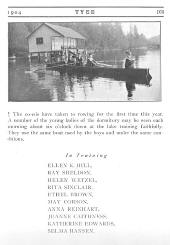 |
1903 is the first
year of documented women's rowing at Washington, with a photo and page in
the 1904 Tyee that noted, “The co-eds have taken to rowing for the first
time this year. A number of the young ladies of the dormitory may be seen
each morning about six o’clock down at the lake training faithfully. They
use the same boats used by the boys and under the same conditions.” A number of factors played into this opportunity. For one, the new campus was surrounded on two sides by water, Lake Union to the west and Lake Washington to the east, and rowing was a natural attraction. But another important factor was the frontier spirit at Washington; to a large degree, Washington was not influenced by east coast "norms" or culture. Their culture was their own, and it was borne out of a closeness to nature, bountiful natural resources, and a location hundreds of miles from the next major urban center. The Washington identity was whatever they made it. And make it they did. Importantly, as part of that new identity, 1903 also marked the inaugural "Junior Day"; what through the decades is now continued at Washington as "Class Day". As described in the early history, "Junior Day" was a university-wide program that included rowing and canoeing (aquatic sports), basketball, athletics (track and field), tennis events as well as other University activities such as log rolling. Both men and women competed in the sports events and at times they competed together in mixed events. The activities and sporting events pitted each class against the other for bragging rights. In addition, each year the junior class planted a tree in front of present day Denny Hall with Professor Edmund Meany, and wrote and performed a farce play. The Junior Day events - sometimes lasting several days – usually ended with the Junior Prom. Although there is no record that the women of 1903 competed in rowing in the first ever Junior Day (May 1, 1903), we do know that efforts were being made for oarswomen to be a part of this unique all-campus event. That paragraph was written by Ellen (Pottmeyer) Ernst '83, a three-time National Champion during the resurgence of women's rowing at the UW in the early 80's, who wrote the complete, detailed history of early women's rowing at Washington in 2005. These early years are published at this link - Washington Rowing History - Women: 1900's, with the program really hitting its stride after 1910 - Washington Rowing History - Women: 1910's. Women's organized rowing was unique at the time and in many ways defines the University's innovative spirit from a young age; but so too is the opportunity to read about it. We hope you take the opportunity to read this exceptionally researched history that Ellen so eloquently wrote to fully understand the legacy - and importance - of the early years of Women's Rowing at Washington. Tyee photos |
|||||||||||||
|
||||||||||||||
 |
Hiram Conibear was hired in the fall of 1906 as a trainer for the track and football teams and - after Jim Knight vacated the rowing job - was convinced by the athletic board to also assume the role of head coach for "aquatics" (rowing) for the 1907 season. With some women already informally rowing out of the boathouse, Conibear made it official and started a women's program, the only one of its kind at a public school in the nation at the time. Conibear - an innovative, intelligent, curious, determined risk-taker - believed in four core principles: hard work; team over self; camaraderie; and rowing to win. Here he is pictured (in the back), early in the establishment of this team, with five of his athletes. Tyee photo | |||||||||||||
|
||||||||||||||
 |
The magnitude of what these women, along with
their coach, were accomplishing by maintaining a daily regimen of rowing at
a university at this time cannot be understated. In 1907 - when this
photo was taken - Theodore Roosevelt was President of the United States;
Oklahoma, New Mexico, Arizona... were not states, and women could not vote
(women would win that right through the ratification of the 20th Amendment
thirteen years after this photo was taken in 1920). There were two women's
rowing programs active at U.S. universities at the time: Washington and
Wellesley. Women's athletics were
not only unsupported in the majority of the country, they were often
admonished as unhealthy for women, particularly in endurance and aerobic
sports. Hiram Conibear did not agree with that sentiment. He encouraged women to row and fought for it multiple times, even risking his job by ignoring an administration that saw women's rowing as dangerous and unflattering to women. Women's Rowing was cancelled by upper campus more than once, but each year would come back with the blessing of Conibear, to the point where by 1913 he was hiring a woman to be the women's head coach. And although formal competition (once a year) was limited to "form contests" competed by class (awarded points by judges for composure, synchronicity, posture, and bladework), informal competition was completely different. As we know from testimonials, that was less an annual event, but much better described as a consistent event: when the women headed out into Lake Washington or Lake Union - and this is particularly true after 1912 when the program had more shells - they went head to head full slide, full power. |
|||||||||||||
|
||||||||||||||
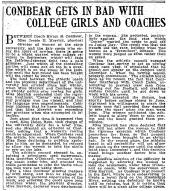 |
A
July 17, 1910 article in the Seattle Daily Times describing the
conflict Hiram Conibear was already having with upper campus over his
women's team. Miss Jessie Merrick, the phys-ed director for women at the UW,
was adamantly opposed to the "rigorous exercise which Conibear prescribes
for them", and denied Conibear and his athletes the racing they wanted,
adjusting practices to instead focus on a form contest. "Miss Merrick
contended that the rigorous treatment "Conny" was giving his fair proteges
was too violent and that his language was ungentlemanly," the article
stated. "She protested, particularly against the long race which "Conny"
wanted the women to pull off on Junior Day. The result was that the women
did not race, holding what was known as a 'form-race' instead". There is a lot packed into this article, but it is important to note that "the women petitioned the UW to allow them to take rowing and the board granted them permission. Miss Merrick has since declared that she will not allow the women to take the rigorous exercise that Conibear prescribes for them, so that present plans have been brought to an abrupt halt." This would not be the first
- or last time - "Conny" would find himself defending the women's program,
and particularly these early women athletes who wanted to race. Seattle
Daily Times, July 17th, 1910 |
|||||||||||||
|
||||||||||||||
 |
Women's athletics at Washington was not limited to rowing; in fact, basketball, baseball, hockey, and track became sponsored sports for women. But by 1912 women's rowing was attracting as much as 10% of the entire coed population on campus, with a program growing so rapidly that everyone - including upper campus - were taking notice. Tyee photo | |||||||||||||
|
||||||||||||||
 |
Two of the more influential women whose coaching
led to the growth in the sport at Washington: Gretchen O'Donnell (l) and
Ethel Johnson (r). O'Donnell is described in the history: "In addition to her dedication to rowing, Miss O'Donnell was on the Hockey team (right halfback) and Basketball team (guard), as well as being assistant editor of the Tyee, member of the Women's League, WAA, Spanish Club, Senior Class Secretary, Varsity Ball Committee, involved in drama, and Senior Class historian. Add to that "coach" of the women's rowing squad in 1911; invaluable to Conibear in these early years, it was her dedication that linked the program from it's inception to the glory years mid-decade." Johnson took over the head coaching role in 1913, "hired by Jessie Merrick as coach/instructor for Hockey and Baseball, and quickly took to the sport of rowing." Tyee photos |
|||||||||||||
|
||||||||||||||
 |
As the community continued to support the
program, more equipment was purchased, and more women joined the team. From
Ellen's history:
“Coach
Conibear recalled the days when the girls started to row in ’06, when they had
to tramp through the snow to the old canoe club and row in a stationary boat
under a leaky shed, from which all the water drained onto the rowers. ‘We owe
everything we have,’ said Connie, ‘to our friends in the city. The ASUW pays
the salary of the coach, but all our equipment has been given us. In the spring
we are going to ask for new shells, for we are in urgent need of new equipment,
and we hope that then we will have more men and women out.’” (The UW Daily,
December 7, 1914) |
|||||||||||||
|
||||||||||||||
 |
From the Seattle Star, February 3rd, 1914, an article featuring Lucy Pocock (sister of George and Dick) and her addition to the coaching staff at Washington. "Miss Pocock believes the English stroke is the best and is teaching it to the girls of the freshmen eight. She promises to give the older crews a hard run for the class championship," states the article. Thank You Al Mackenzie and Seattle Star; added 3/23 | |||||||||||||
|
||||||||||||||
 |
Always the optimist, always the believer, and always - like Dick Erickson some 70 years later would say - an "opportunitiest", Hiram Conibear was killed in a freak accident in his backyard picking plums in September of 1917. That same year the U.S. had entered World War I, and suddenly a perfect storm of circumstances was weighing on the program. Washington Rowing - in a matter of months - was abruptly and irrevocably changed. By the time the war was over a year later, rowing across the country was being redefined, but none more so than on the west coast. Cal's men's program was teetering on the edge of extinction, and Stanford's men's program was cancelled and would not return for 60 years (neither of these programs ever had women's rowing to begin with). As Ed Leader took over at Washington, it was all he could do to keep any rowing alive against a backdrop of anti-athletic sentiment on upper campus, and a community reeling from the war. In those years of turmoil one of the greatest casualties at Washington was women's rowing. Without their strongest advocate in Conibear, and without the funding or the facilities as the men's team moved to the Navy Hanger on the new Montlake Cut, women's rowing - and the unique opportunity it afforded the many young women who participated - would disappear from campus for decades. | |||||||||||||
|
||||||||||||||
 |
Following the death of Hiram Conibear in 1917 - the lifeblood of the early women's rowing program at Washington - and the post WWI changes on campus, women's rowing took a decades long hiatus at Washington. It was not until after WWII that rowing began to re-emerge as a physical education alternative for women; here are some of the earliest young athletes trying out the sport as an IMA offer in Old Nero, launched from the ASUW shellhouse in the spring of 1949. UW Archives photo | |||||||||||||
|
||||||||||||||
 |
Joan Bird was the catalyst in the re-birth of Women's Rowing at the
University of Washington in the fall/winter of 1968. A transfer from Mills
College where she rowed, Bird was surprised to find the UW had no such
program for the women at the UW. “I first visited Norma Carr down in the
Intramural Building to sign up for women’s crew and was surprised when she
told me there was no such thing,” Bird said in an interview with the Helena
(Montana) Independent Record in 2010. “She said it was because there
was no interest, but when I told her how much I’d enjoyed the sport and
couldn’t believe there wasn’t interest, she volunteered, with a
conspiratorial smile, ‘If you can demonstrate there is an interest, the
university is obligated to supply you with equipment.’” An interest there was. Thirty women signed up and coach Bernie Delke was hired as the intramural coach, the women borrowing the intramural men's equipment (wherry fours and eights) on Tuesdays and Thursdays. In April of 1969, they entered their first race at the Corvallis Invitational at OSU, driving their own cars south with oars strapped to the roofs, and borrowing racing shells (actual shells, not wherries) and for the first time attempting to set the boats on the way to the starting line. It was an adventure, but by June the team was rowing in shells borrowed from the men's team, and subsequently raced at the NWRA Nationals on Greenlake, placing 3rd in both the lightweight 4 and lightweight 8 events. Ellen Ernst, who wrote the detailed UW early year history, added, “Participation in the 1969 nationals ended the rebirth year, and the first racing season for the UW women’s crew. Joan Bird had the vision and energy to reintroduce the sport [and] the women were excited to continue rowing and competing — and in making up for the 50 years of lost time! They were hooked!” Thank you Helena Independent Record, June 16, 2010. Photo: UW Tyee, added 3/23 |
|||||||||||||
 |
By the late 60's, the women were an official club sport at Washington and were becoming more organized, with a new head coach in Bernie Delke. The 1969 Women's Varsity Club team, back row: Alice Anderson, Carol Owens, Susan Cook, Linda Cles, Joan Bird, Marie Swanson, Jody Curry, Coach Bernie Delke; bottom row: Pat Gustke, Jan Richardson, Julie Johnson, Coleen Lynch, Jeanne Waters, Molly Skerbeck, Suzi Louie, Denise Etcheson, Penny Nattress. Tyee Photo | |||||||||||||
 |
Over forty women were already making up the roster of the women's team in 1969, including Cathy Kann in the two seat, and Nancy Engard rowing three in this photo from the UW yearbook. Tyee Photo | |||||||||||||
|
||||||||||||||
 |
The 1970 novices out in Old Nero (with coach Delke in the stroke seat). The women rowed and trained out of the original ASUW shellhouse (known as the "canoe house" after the men vacated the building in 1950), so this photo would have been taken right after launch into Union Bay. The "canoe house" was dark and cold and the dock was small, but that did not dissuade these club athletes from learning and competing in the sport. Out of this team came the first NWRA National Championship for the UW, in the 1970 Lightweight 4+. Tyee Photo | |||||||||||||
|
||||||||||||||
A series of photographs from May of 1970 when Terry Drinkwater, the CBS National News west coast correspondent, brought his CBS TV production team out to Seattle to film the nascent women's rowing program at the UW. The impetus for this visit was an April 1970 article in the Christian Science Monitor, written by UW Communications writer Mary Ellen Campbell, titled "To be a part of that motion, grace; It's the reason why young ladies are rowing". In the article Campbell explains that the new program, led by Coach Delke, has 42 current athletes, that the team launches from the "Canoe House" (the contemporary term for the original ASUW shell house on the Cut), and that practices begin at 6:30 a.m. "Unlike European women's teams, American women are just beginning a crew program," the article states. "There is much organizing necessary. Development of facilities and acquiring the elaborate equipment for rowing takes time. But the University of Washington girls are excited about blazing the way." "When it goes well everyone knows it. It feels good. That good feeling is both the goal and the reward for the rowing. It takes work; the yellow shirts worn by the women's crew were a familiar sight in the weight room of the Intramural Building all winter. Working on weights, coupled with running to build endurance and wind, the team awaited spring weather to begin training on the water once again." In the photos above the original yellow shirts - paid for by the women themselves - can be seen as the women launch from the shell house. The wherry shells were carried out of the double doors in the back of the building and walked over to the east facing docks of the Waterfront Activities Center where the team launched. A young Bernie Dehlke is seen talking with Drinkwater at the shell house, and as the team is filmed near Fox Island at the eastern end of the Cut. The CBS production gave the sport and the
UW program significant national exposure at a time when rowing was just
emerging as a competitive alternative for women. That summer, on Lake
Merritt in California, the UW women won their first National Championship,
in the Lightweight 4+. Thank
you Christian Science Monitor, April 23, 1970; photographs and
sourcing thank you Al Mackenzie; added 3/23 |
||||||||||||||
|
||||||||||||||
 |
The 1971 National
Champion Lightweight 8 at the 1971 NWRA Nationals in Old Lyme, Connecticut,
holding the NC trophy: in front (with trophy) is coxswain Marilynn Goo, and
per Marilynn the following: Jean Turney is standing in back with the
sunglasses and camera; front - Coleen Lynch, Pam Hall, and Randi Mattson.
Mary Lou Talbot is behind Pam and Randi; Paula Mitchell is in the hat and
sunglasses behind Randi, with Ann Pace next to her. These early teams were not funded by the University, so they were on their own when it came to travel, coaching, operational/daily expenses... even down to the uniforms. "As a club sport, we did not receive university issued uniforms", said Marilynn. "Someone would go buy shirts and then take them to have the UW Women’s Crew logo printed on them... I remember going with Jan Holman (Jan Harville) and someone else to J. C. Penney where we bought the purple henley shirts for the 1972 racing season." "Kit Green (UW Assistant Athletic Director) was very supportive but I don’t think the University contributed much since we were a club sport. The fundraiser that I remember is selling crew buttons. We had some buttons made to sell and on Opening Day we would take out canoes from the canoe house (the original ASUW shellhouse on the Cut) so that we could sell them to the people lined up to watch the races. We also had people working the crowds on land." This 1971 team dominated the lightweight events at the NWRA's in 1971, winning the lightweight single, lightweight 4+ and the lightweight 8+ at Nationals. Thank you Marilynn Goo |
|||||||||||||
|
||||||||||||||
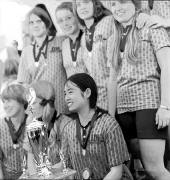 |
The 1972 lightweight 8 with the repeat National Championship performance at the 1972 NWRA's: Back row: Liz Senear, Gigi Coe, Pam Gilmore, Susan Karpiak. Front row Randi Mattson, Jackie Frye, and coxswain Marilynn Goo. The UW lightweight quad also won the National Championship in 1972. Photo: thank you Marilynn Goo | |||||||||||||
| The
three photos above are all from the scrapbook of Debby Tonge Jackson '73
(pictured 2nd from left in the 1972 Open 4+ above, and third from left in
the Open 8+). "There are a lot of crew memories for me but the most
important is the legacy of being an athlete for the first time ever," said
Debby. "I went to Roosevelt High School in Seattle when there weren’t any
sports for girls - and I never figured I was cool enough to be a
cheerleader. I always figured I would attend the UW, and in the fall of my
junior year, I read in The UW Daily about a meeting for women interested in
joining crew. I decided I wanted to meet other girls and to join a group,
though I thought maybe I was too big - which I learned was pretty funny
since I was 5’5” and about 132 lbs. Turned out I did pretty good in the
weight room (especially the leg press) and Bernie Dehlke, our coach, had
me row heavyweight. I think I was pretty proud of that." She continued: "I remember traveling to Corvallis to race... we heavyweight girls ate ice cream at the drive-in but the lightweights couldn’t since they had to weigh in, and I remember the drive home from Corvallis one year at night when it was my turn to drive... and I didn’t really drive much at all usually. I remember Nationals in 1973... first to Philadelphia where we got to go upstairs in the 747 airplane, and stayed at the Benjamin Franklin Motor Inn and rowed on the Schuykill River, and wandered around Philly and saw the Row Houses and Delis that were so different from Seattle. We stayed after the regatta to sightsee in Washington DC, driving around in Randi Mattson’s red VW van during a huge rainstorm, and sleeping overnight in a National Park on the outskirts of DC." "I loved the camaraderie with the other women on the team and I loved Bernie (Dehlke, head coach), but mostly I loved the rowing. And I still do all these years later. It truly is a beautiful sport! So, I guess I’d have to look up the details of the race times, lineups, and medal counts... but it seems it’s the team and the sport that stick with me all these years later. Rowing is probably the best thing that has ever happened to me and it’s made me what I am; I even met my husband through a teammate, had two great children (who both rowed in high school, and my daughter for two years at UW), and now am a happy grandmother, all thanks to rowing." Photos thank you Debby (Tonge) Jackson |
||||||||||||||
|
||||||||||||||
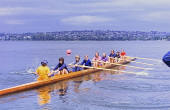 |
The 1973 Washington Varsity Lightweight 8 on Greenlake for the spring regatta... Photo: thank you Marilynn Goo | |||||||||||||
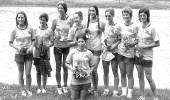 |
...and together on the docks at the NWRA Championships in Philadelphia with the third National Championship in a row, left to right: Mary Dion, Dena Peel, Barbara Mitchell, Marylou Talbot, Chris Satterlee, Julie Gustafson, Randi Mattson, Kathy Roberts, and coxswain Laurie Bennett. Photo: Washington Rowing | |||||||||||||
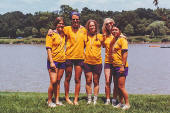 |
The 1973 Open 4+, left to
right: Liz Senear (stroke), Jan Holman (3), Joanne Williams (2), Debby Tonge
(bow), and Marilyn Goo (cox). By 1973, the UW Athletic Department (via Assistant AD Kit Green) was providing airfare and hotel rooms for the women athletes. "I am pretty sure the trip to Philly was paid for by the UW," said Debby (Tonge) Jackson. "I know neither I nor my parents paid — I was totally awestruck by that! I think I escaped a lot of the hardcore fundraising, maybe because I only rowed my junior and senior years." Photo: Thank you Debby (Tonge) Jackson |
|||||||||||||
|
||||||||||||||
 |
In the fall of 2020, BJ Connolly - a rower now for decades - wrote a memory for the LWRC newsletter and shared it with us. The corresponding photo is in that same timeframe (1973 vs 1975), and gives a visual representation of the days when Dick Erickson would take his team through the locks and out into Salmon Bay. Here is what she wrote: "Human-powered vessels typically don’t venture through the Ballard Locks. And Husky crews usually don’t head for open water of the saline variety either. But one day in the spring of 1975, two worlds converged. But first, step back in time to 1972-73. It was my freshman year, and Washington won the NWRA National Championship on the Schuylkill River. With that accomplishment, we realized that the UW was beginning to embrace the ideologies of Title IX. We were in the thick of it, trying to work with the men’s team to continue to be recognized as a varsity sport despite the decades of male dominance and tradition that permeated the aura of Conibear. The saving grace for women’s crew? Head Coach Dick Erickson, who absolutely loved the idea of having women row for Washington! He wholeheartedly supported our efforts, providing launches for our coaches and designating one boat bay for us. Dick’s encouragement gave senior rower Liz Senear and me the courage to ask him if we could convert one of the men’s pairs to a double. Liz had set her sights on making the U.S. National sculling team for the World Championships in 1975. With a double, we could train every day. The guys thought, “What?” But Dick supported us. And he loved being controversial, always keeping the men guessing. So, he found old sculling riggers at the Pocock workshop. Boom! We were in business! One day, we learned the men (including my future husband, Mike) were going to row to Shilshole Bay via the Ballard Locks. We asked Dick if we could join the fun. Leading the way to keep some distance from the eights, we entered the locks. Imagine all those shells in such a tiny space! Oars overlapping. Anxious coxies avoiding the walls. Lockmasters barking orders while the water was slowly released to the west and we went down, down, down. Dick positioned our double in the middle of all the eights for protection. What a spectacle for the crowd! It was hysterical to hear some of the rowers perfectly imitate the Scottish accent of one of the lockmasters. Even Dick chuckled, totally enjoying the moment. It was a once-in-a-lifetime event! And Liz did attend the World Championships as a spare for the U.S. quad!" 1973 VBC Yearbook photo |
|||||||||||||
|
||||||||||||||
 |
Title IX was signed into federal law in 1972, the result being women's rowing officially established as a Varsity sport at the University of Washington in 1975. Here, that Varsity Team practices on a glassy Lake Union in 1975, Gasworks in the background. Kate Camber photo | |||||||||||||
|
||||||||||||||
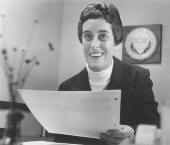 |
Kit Green was
hired by the University of Washington as a PE instructor in 1960. By
1969, she was administering the IMA and overseeing women's club teams at the
UW, including the IMA rowing team, in an office that "resembled a closet"
according to the Seattle P-I in a 2007 article on her legacy. Brought under
the Athletic Department umbrella in the early 70's, it was Kit who helped
fund the women's team even before Title IX changed the landscape. By
1975 - as the newly established Senior Associate Athletic Director for
women's sports at Washington - Kit was integrating eleven women's club teams
into the varsity program at the UW. "At the outset, only limited funding was provided by the University," Kit said in a 1999 interview when she received the Nike Lifetime Achievement Award for Women in Sports. "We started with no scholarships, no lockers, part-time local coaches, no trainers, one set of uniforms, private cars or school buses for transportation... just the bare bones." She added in 2007, "I do remember the beginnings, and they were tumultuous." But through her commitment, by 1980 women's varsity sports were fully established on an equal footing at the UW. It was through her leadership that every facet of the rowing program at Washington met the same standards as the men, overseeing the steady growth of the sport and ultimately a run of National Championships that remains unprecedented today. "I am proud of the fact that I was able to persevere and survive under often difficult circumstances, including a sometimes hostile environment, and was instrumental in creating a viable program of intercollegiate athletics for women at Washington," she said in 1999. Kit Green's influence and impact on women's athletics - holistically - cannot be understated. She was a pioneer at Washington, but also regionally and nationally recognized as one of the early adopters and "change agents" for equality in athletics. Her unwavering desire and positive energy that she brought every day to her job is still felt today... and none more than women's rowing at Washington, a sport and team that she so deeply valued from the very beginning. UW Athletics photo; Thank you to The Tyee Difference, spring 2022, and the Seattle P-I, April 5, 2007 |
|||||||||||||
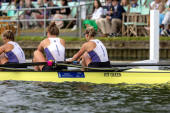 |
At the 2022 Henley Royal Regatta, the Washington Varsity 8 raced in the Remenham Cup (the top event for women) in a brand new Empacher eight named the Kit Green, in honor of Kit and her influence on the program still felt today. "It was an honor and a privilege to race in the Kit Green at Henley, just in time for Kit's 90th birthday, Title IX's 50th anniversary, and in the midst of Henley's continued expansion of women's events", said UW Women's Head Coach Yaz Farooq. UW Rowing photo; added 2/23 | |||||||||||||
|
||||||||||||||
 |
In the spring of 1975, in the first year that women's rowing was re-established as a varsity sport at Washington, the UW women launched their first new shell since the days of Hiram Conibear, and it was aptly dedicated to Dolly (McLean) Callow '13. Callow was a consistent figure in the rebirth of women's rowing at Washington, and is seen here (center) with Lucy Rochester (left) and Karen Anderson (right) at Seward Park prior to the boat dedication. Callow, in her days as a rower with Hiram Conibear as her coach, told Al Ulbrickson Jr. in his 1963 history compilation: "While the girls' program was not supposed to be competitive in the least, it was not unusual for two or more girls' crews to compete unofficially when out of sight of the boathouse..." For this new team, her competitive spirit and connection to the past were highly inspirational; and as the women set out in the spring of 1975 to lay the foundation for teams to come, it was that same alumni tradition -- to support and inspire -- that is at the heart of our values today. Thank you Kate Camber '78 (Kathy Bulger) for the photo | |||||||||||||
 |
The women's team on the Conibear apron with the brand new Dolly Callow. "The first race in the Callow was a victory for the lightweight eight," said Kate Camber of the victory at the NWRA Regionals, June 1, 1975. "The Callow was Stan's first attempt to make an eight for women... it had so much flex, only lightweight women could row it, much to the lightweights' delight." Thank you Kate Camber '78 (Kathy Bulger) for the photo | |||||||||||||
|
||||||||||||||
 |
The combined (open and lightweights) women's team collecting the overall team points trophy - from Stan Pocock - at the 1976 Western Regional Collegiate Women's Rowing Championship. Kate Camber photo | |||||||||||||
|
||||||||||||||
 |
Honoring Our
Women's Captains: 1975 - 1978 Originally published in SWEEP Magazine, Fall 2017, Eric Cohen With the re-emergence of varsity women's rowing in 1975, these three women helped define the future of the sport at Washington. Left to right: BJ Connelly (1975 co-captain), Kathy Bulger (1976, 1977 captain), and Linda Cox (1978 captain). In an article written for Sweep Magazine in 2017, they discussed the early days of women's rowing and what Washington Rowing has meant to them: BJ Connolly Captain in 1975, BJ began rowing when the sport was still an intramural sport for women at Washington, and they rowed out of the old Navy Hangar on the Montlake Cut. “The old shellhouse was dark and cold but we did not care. Competition was strictly local against crews like Greenlake and LWRC. Who would have thought that by the end of my freshman year we would be winning the NWRA National Championship in the lightweight eight… to have been a part of those boats was an unbelievable experience. Because of our success that year, our coaches (Paula Mitchell and Coleen Lynch) approached Kit Green and Joe Kearney (the UW athletic director) and asked to make us an official varsity sport. They didn’t, but the next year (1972) we did row out of Conibear Shellhouse, which was a much better facility, but with it brought the challenge of being the first women’s team to share the shellhouse with the men. By my senior year additional universities had also started their programs; UCLA, Cal, Oregon State; and we were all creating history for our schools: racing at the Western Sprints (prelude to the Pac 12 Championships), watching the National NWRA Championships grow and the best race of all: being the first Husky Women's Crew to compete in Opening Day. Coming from a broken home, the girls were like my second family. I did not see my father from the time I was 12 until my senior year at Washington. One afternoon at the shellhouse I was astounded to discover his name (Fred Mitchell ‘48) on the big W board, which caused me to contact him and share that I too, was now a Husky rower. Who would have thought? That connection changed our relationship. Whenever I see his Washington oar on my wall with its leather collar and brass fittings along with his photo as he sat in bow (his nickname was "The Rail" because he was 6'4 and thin).....you can see the total joy on his face. I like to think that was one of his happier times. Now being in my early 60's I am still rowing and have been for the past 28 years. I never dreamed back then, that this would become a lifetime sport. Husky rowing taught me that life is all about connecting. People love to hear what rowing is all about and those that know the sport know that the tradition of excellence, giving of yourself 110% for a team effort and being able to handle the work load of training with studying are all challenges we overcome. And after you graduate, because of that you can handle any experience with fortitude and grace. The skills you learn as a rower will serve you for years to come! “ Linda Cox Fornaciari Captain in 1978, Linda is the only coxswain added to the Captain’s Wall in this group. “I like to say that my four years as a coxswain was where I learned how to tell taller people what to do, and haven’t stopped since. But the truth is that Washington Rowing taught me the power of a group working together, and how each individual adds their particular strength to the whole to do what seems impossible. Quite frankly, once you have worked this hard and this many hours in the dark and rain, you have an innate confidence any place you go. I became a corporate attorney and could always look anyone in the eye and think they never could have done the crazy early practices, the 100 sets of stadium stairs and work as hard as we did. You simply cannot be intimidated and you know you can work harder than anyone else in whatever you do. In the late ’70’s there was active opposition to women rowing by the men’s team… except for the few who were our friends. Title Nine brought us more equal benefits, but as the first group of women inducted into the Varsity Boat Club, we faced hostility. The strong bonds we developed, knowing we could count on each person in our boat in a crunch, always pulled us through, in a race or any time we needed each other. We laughed and cried and figured out how to deal with the stress of being moved in and out of boats, clashes among teammates, and losing weight - - lightweight crew and coxswains were always hungry! Six of us have gotten together once or twice a year for the 40 years since graduation, and we love seeing other teammates at UW events. My son and daughter tease me when I take pride in our Pac-8 Championships, given that it is the Pac-12 now. But I know that the amazing women rowing today for the UW are forging this confidence and strong connection with their teammates now. I hope they will treasure it and carry it with them forever. “ Kathy Bulger (Kate Camber) Kate was elected captain in both 1976 and 1977 by her teammates, and for good reason: she was a leader both on and off the water throughout her career at Washington. “All of us loved rowing – to me it was the best part of my day… as a sport it is individual and it’s a team, I loved that part of it. It was where I could challenge myself but also so enjoy being a good rower; but what kept us going was we were doing something together at a level very few athletes get to. When you can rely on other people… and feel the swing together in the boat… those relationships stood above and beyond anything else in my life at the time.” As captain in 1977, Kate was instrumental in bringing women into the Varsity Boat Club for the first time. “The men – most of them – did not like us being there. It was hard,” she said. In the spring of 1977 however, she prevailed in opening the VBC to women, and said at the time: “I am looking forward with a lot of hope” to being a VBC member. Sixteen women were inducted into the VBC for the first time that year. Training changed season to season, but in the first years she said, “We never rowed on the ergs. In the fall we rowed in Old Nero and ran stairs, but I was one of the only rowers with previous experience (Kate rowed at Greenlake in high school under Kathy Whitman), so we did a lot of skill and drill because there were so many first-time rowers. In the spring we would race each other on the Evergreen Point floating bridge… we worked really hard.” The highlight for Kate was not in the multiple NWRA Championships she won as a Husky, but the intrasquad racing on the Cut: “We didn’t have a lot of ham’n’egger’s, but they were an opportunity to be strong individually and meet the challenge of a completely random line-up. And my freshmen year… I just rowed for the enjoyment. It never occurred to me we would lose, and we didn’t. I felt powerful and had a sense of myself, people believed in me and I believed in them and we never said anything about it. There’s an ineffable quality about it.” “I always remembered my rowing career as a really special time, it was my refuge, everything fell away, I didn’t have any problems. You have to be in the moment every moment when you are rowing. When I got into the rowing shell my life was perfect. And I was aware of that. It was so beautiful. The sounds of the bubbles, on the cedar shells, Mt. Rainier, the sunrise over the Cascades – it was like music. When you have the run, and the drip, drip, drip off the oars… it was almost perfection.” |
|||||||||||||
|
||||||||||||||
 |
The 1977 Varsity squad on their way to the Pac-8 Championships, May 1977. 1977 Yearbook Photo | |||||||||||||
|
||||||||||||||
 |
The Varsity Lightweight 8+, gold medalists at the 1978 San Diego Crew Classic in a time of 3:24.7 for the 1,000 meter course, with Cal in second at 3:26.1 and Lake Merritt 3rd in 3:38.1. Left to right: Lisa Miller, Carol Lake, Kay Cockrel, Gayle Graves, Kathy Hamlin, and stroke Kathy Rousso. HRF photo | |||||||||||||
 |
The 1978 Flyweight (115 lbs) National Champion 4+ rowing in the Lucy Pocock Stillwell, left to right: Julie Jones, Mary Hartman, Kathy Hamiln, Di Schueler, and cox Lisa Drumheller; and closest photo, at the National Championships with coach - and the builder of the Lucy Pocock Stillwell - Stan Pocock. HRF photo | |||||||||||||
 |
The 1978 Flyweight team after receiving their awards with their coach - and the builder of the Lucy Pocock Stillwell - Stan Pocock. UW Rowing photo | |||||||||||||
|
||||||||||||||
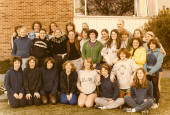 |
The 1979 Women's team in front of Conibear Shellhouse. Photo thank you Betsy (Mayer) Eisses | |||||||||||||
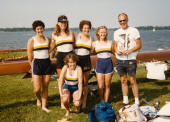 |
The 1979 Pac-10 Champion Open 4+, at the Women's Nationals at Stony Creek, Michigan, left to right: Jean Bulger, Mary Stoertz, Betsy Mayer, Cindy Wilson and head coach John Lind, with coxswain Karla Godwin kneeling. Photo thank you Betsy (Mayer) Eisses | |||||||||||||
|
||||||||||||||
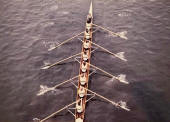 |
The 1980 Lightweight 8 on their way to the Pac-10 Championship at Redwood Shores. Thank you Cindy Spranger McCormick | |||||||||||||
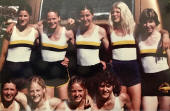 |
1980 Pac-10 Lightweight 8 Champions. Photo thank you Cindy Spranger McCormick | |||||||||||||
| The
1980 Women's Lightweight team continued the strong tradition, dating back to
1970, of the UW fielding championship level Lightweight squads. Cindy (Spranger)
McCormick (4-seat in the 1980 Lightweight 8) recently remembered that year:
"That year we were undefeated, I believe, and our boat was always so strong
no matter who was in it. The roster changed a bit because a couple of the
rowers were in the Varsity 8 for most of the regular season and then moved
into the Lightweight boat for Nationals. Those that joined the boat later
just fit right in and the boat didn't lose a beat. This boat had the best
swing! You felt a little like you were just skimming on top of the water. We
believed in ourselves and supported each other...we all wanted to win but
knew we could only do it together. Now every spring there are days
that I walk out of my house and the air just smells like rowing. I close my
eyes and can feel myself back in a boat..." Photos: Thank you Cindy Spranger McCormick. |
||||||||||||||
 |
In the summer of 1980, Dick Erickson announced that men's freshmen coach Bob Ernst - whose frosh teams went undefeated four of the six years he coached and won six straight Conference Championships - would take over as head women's coach at Washington. Ernst quickly hired Jan Harville, UW alum and two-time Olympian, as his Novice women's coach. "With Bob Ernst now coaching the women's varsity, and with Jan Harville and Gil Gamble coaching our first-year athletes, we have the most experienced and complementing coaching team in the business," said Erickson. "Washington will now achieve its goal of one rowing program for both men and women." HRF photo | |||||||||||||
|
||||||||||||||
 |
The
1981 Varsity 8+, the first women's open eight Varsity National Champions in
the history of the Washington women's program. Out of the gates with a
2-seat lead into a slight headwind, Washington and Yale had separated
themselves from the pack by the midpoint. Yet it was in the final 200m that
the Huskies pulled away, winning in 3:20.8, Yale second in 3:22.9.
"When this crew is ahead, there's not a chance of catching them," said first
year coach Bob Ernst after the race, adding, "I like coaching these women.
They win all the time. But they paid for it... they paid in the weight room
and they paid on the water." Left to right: Head Coach Bob Ernst, Debbie Moore (bow), Madeline Hanson, Sue Broome, Karen Mohling, Peg Achterman, Kris Norelieus, Shyril O'Steen, Jane McDougall (stroke) and Lisa Horn (coxswain). Out of this team, Broome, Norelius, and O'Steen would become Olympians, with Bob Ernst leading the USA Women's eight to gold in 1984. Source: The Oarsman Magazine, June/July 1981; HRF Photo |
|||||||||||||

|
Peg Achterman,
five-seat on the 1981 team and long-time Washington Rowing Steward, said in
2017: "I came to rowing as a sophomore after being on the track and field
team my first year. Laura Jackson and Katie Fox — who were just ahead
of me — they convinced me to shift. I also give a lot of credit to Ken
Shannon (UW track coach) for making me a better athlete for success as a
rower, and I also looked up to Kris Norelius (AND at her back a lot!) since
she’d been on the USA Olympic team in 1980. We all learned about the ’36 crew from the start and I think just knowing the traditions and successes of UW rowing over the years makes all the difference. The women’s teams had had a few successes leading up to the ’81 championship, but not like the men. It was still too early to look to the women of the mid 70s - even though we knew Jan did well. Those stories were more about a few who were on the National Team or in the very successful lightweight boats. I guess I like to think that even though it wasn’t the Olympics against the Germans - that first open-weight National Championship boat is pretty special in the history of the women’s program at UW. I was just in the right place at the right time. So, maybe the young women now look at us and think the same thing I thought about the ’36 guys - 'wow, they’re old!' But particularly for the young women, I think those of us from the late 70s and early 80s are a good reminder of how far the program has come... and also how far women’s athletics have come. Title IX wasn’t even a decade old when I started at UW in ’78; the fact that the current rowers see the alums regularly at events is just a far-reaching influence. And the fact that names are attached to scholarships, to shells, to rooms and such - they see what it takes to keep UW Rowing strong." She also remembers her first win over Cal: "We had glorious weather on Opening Day of 1981 and it was back in the days when this meant the Cal Dual race (every other year). 1981 was the first season with the women for Bob and we’d surprised everyone at the Crew Classic with a win, and Opening Day was our chance to show that we weren’t a fluke... but we only had about 3 minutes to do it since we were still racing 1,000 meters rather than 1,500 or 2,000. That meant our halfway was at the opening of the Cut... and all I remember was the noise as we started to move on Cal. We could barely hear Lisa Horn (our coxswain) but we knew we were moving and by the time we hit the bridge we were ahead by a few seats. Once we crossed the finish line I could hardly hear OR see — everything was pounding, we were all gasping for air, but we’d won the Cal Dual for the first time. Every time we have a nice sunny day on Opening Day I think about that race as a junior and the confidence it gave us to go on to win the National Championship that year. I appreciate that the traditions have
mostly stayed the same - whether it’s how we christen shells, or how teams
work together - Washington Rowing is steeped in commitment to the team and
to excellence. The other thing that remains constant is our course and
our lake. It doesn’t matter where I am in the waters of the north end of
Lake Washington, or Lake Union, the Cut, the Ship Canal - I can remember a
practice or a race. The Mountain is still there - kind of saying 'think
you’re so tough?'" Thank you Peg Achterman; Interview with Eric
Cohen 9/2017; UW Rowing photo |
|||||||||||||
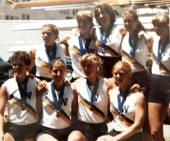 |
The 1981 National
Champion JV8, the first 2V8 NC in the history of the program, left to right
front row: Ellen Pottmeyer, Cindy Spranger, Sharon Ellzey, Penny Craig; back
row: Monica Kronlof, Nancy Leppink, Karla Goodwin, Marisa Velling, and Sue
Winters. "The 1981 JV8 was special because a lot of us started out in the last boat," recalled Cindy (Spranger) McCormick. "We worked extremely hard with the help of our coach, John Squadroni. Part of that work was bonding through laughter... I remember looking forward to practice because we had so much fun together, even though we were working our butts off. We did the work and made it into the JV boat and showed what we were made of... the National Championship was so satisfying because our boat was so strong, and we had worked so hard to get that win. Crew instilled in me a belief that I could do anything I set my mind to. I didn't join Crew to win. I joined because I liked to canoe and it seemed similar. I came from Chicago and hadn't ever rowed in a shell before, but once I started rowing, I realized I was good at it... but I still never thought about winning. I just went to practice and worked out and had fun. But that first time the boat started to swing together and fly across the water I thought, this is amazing! I thought you could do anything by working towards your goal a little at a time." Photo: Thank you Cindy Spranger McCormick. |
|||||||||||||
 |
Karla Godwin hits the drink after the first 1V/2V sweep in the history of the UW women's program at Nationals. Photo: Thank you Cindy Spranger McCormick. | |||||||||||||
|
||||||||||||||
 |
An artist's snapshot of the launching of the state-of-the-art Bodacious in 1982, a gift from the Hunter Simpson family and the first gifted 8-oared shell to the women's team. This brand new Pocock shell (what Stan Pocock referred to as a "C"-shell, the "C" standing for a composite of "fiberglass, urathane foam, kevlar, carbon fiber and epoxy resin") honored the 1981 National Championship, while at the same time continued to meet Bob Ernst's goal to equalize the women's program with the men. HRF photo | |||||||||||||
 |
The stern six of the 1982 National Champion 2V8, left to right: stroke Sue Winters, Marisa Velling, Sharon Ellzey, Janise Fulton, Ellen Pottmeyer, and Madeline Hansen. Not pictured: bow pair Debbie Moore and Monica Kronlof, and cox Betsy Beard. UW Rowing photo | |||||||||||||

|
Two photos of the 1982 Varsity 8+ National Champions, rowing in the Bodacious (note the stripes next to the coxswain's seat), bow to stern: Loren Smith, Karen Mohling, Sue Broome, Peg Achterman, Margie Cate, Kris Norelius, Julie Baker, Jane McDougall (stroke), and Lisa Horn (coxswain). The women's collegiate race distance shifted from 1,000m to 1,500m in 1982 and 1983; then shifted back to 1,000m during the Olympic year of 1984; then permanently went to 2,000m in 1985. UW Rowing photos | |||||||||||||
 |
The 1982 Women's team after sweeping the eights at the Cal Dual Regatta: top row: Varsity; middle row 2V8; bottom row Novice 8. Every athlete in this photo went undefeated in 1982. UW Rowing photo | |||||||||||||
|
||||||||||||||
 |
Members of the 1983 USA women's eight, silver medalists at the Senior World Championships in Duisberg, Germany, left to right: Shyril O'Steen (UW); Carie Graves; Carol Bower; Kris Norelius (UW); and Jan Harville (UW). | |||||||||||||
 |
On the cover of the Oct/Nov 1983 Rowing USA Magazine, the 1983 USA Women's 8 on the podium at the Wedau Sports Park in Duisburg, Germany. At the 1000m distance this race was over in a flash, the USSR and East Germany out in front in the first half, but the USA charging back in the last 500m to take the silver. Left to right Kris Thorsness, Pat Spratlen, Shyril O'Steen (UW), Carie Graves, Carol Bower, Kris Norelius (UW), Jan Harville (UW), Holly Metcalf and coxswain Val McClain. USRA photo | |||||||||||||
 |
The 1983 National Champion Varsity 8+, stern to bow: coxswain Betsy Beard, stroke Loren Smith, Julie Baker, Eleanor McElvaine, Karen Mohling, Jan Fulton, Ellen Pottmeyer, Sara Nevin, and Maureen King. Washington Rowing photo | |||||||||||||
 |
Members of the the Class of '86, undefeated Pac-10 Champions in 1983, left to right: Trudi Holt, Kristi Stingl, Jennifer Schifsky, Mary Winecoff, Paige Nilles (stroke) and Lynne Kalina, coxswain. Washington Rowing photo | |||||||||||||
|
||||||||||||||
 |
Hunter and Dolly Simpson (far right) with the 1984 Varsity and their newest shell, the Eagle. The Simpson family in 1984 gifted both the Jane's Friendship (rowed by the 1984 Women's Olympic team) and the Eagle to the team. Washington Rowing photo | |||||||||||||
 |
The 1984
Women's Varsity 8+ National Champions, left to right: Liz White, Kristi
Stingl, Chris Campbell, Cherie Gawley, Liese Hendrie, Eleanor McElvaine,
Sara Nevin, Gail Stewart (stroke), Jeannie Bucko, coxswain, and interim
coach John Squadroni (Bob Ernst took a leave of absence in 1984 to coach the
USA Women's National Team to Olympic Gold in Los Angeles). The National
Championships were held at Greenlake in Seattle in 1984, the V8 taking the
1,000m race in 3:29.5, with Radcliffe (Harvard) a half length back in
3:31.10.
Washington Rowing photo |
|||||||||||||
|
||||||||||||||
 |
The 1984 Olympic Champion USA Women's 8+ - coached by Bob Ernst - on the podium left to right: Jeanne Flannagan, Holly Metcalf, Carol Bower, Carie Graves, Shyril O’Steen (UW), Kris Norelius (UW), Kris Thorsness, Kathy Keeler, Betsy Beard (UW) Tom Cohen photo | |||||||||||||
The Final of the 1984 Olympic Women's 8+ Rowing event as called by NBC's Kurt Gowdy and a youthful Steve Gladstone. Like the '36 team, you know the outcome... but still very, very much worth the watch... about as perfect of a crew race as you will ever see. "There's no defense in a 1,000 meter race. It's all offense." - Bob Ernst |
||||||||||||||
 |
Huskies Betsy Beard, Shyril O'Steen,
and Kris Norelius celebrate their gold medal performance in the USA 8+ at
the 1984
Los Angeles Olympics on Lake Casitas. HRF photo
|
|||||||||||||
|
||||||||||||||
 |
The 1985 Varsity 8 with the new* Jane's Friendship, a gift from Hunter Simpson by way of the 1984 Olympic Team. It was Bob Ernst - looking for the very best equipment for his Olympic team in LA - that first approached the Simpson family about funding the brand new Empacher. Hunter agreed, but only if the shell ended up back at Washington. "The pitch was, 'Hey, Hunter, how about coming to L.A. and the Olympics and watching your boat win a gold medal?' " Ernst said in a Seattle P-I interview, the shell originally named "Friendship" (thus the asterisk above) and, as predicted by Ernst, the victorious shell rowed by the USA women at the 1984 summer Olympics. A few months later and back in Seattle, the shell was re-christened the "Jane's Friendship" in honor of the late Jane McDougall, stroke of the first National Champion V8 (1981) in program history. UW Rowing photo; thank you Seattle P-I | |||||||||||||
 |
The 1985 V8 National Champions, closing out a run of five straight National Championships from 1981 - 1985, stern to bow: coxswain Lynn Kalina, stroke Chris Campbell, Sara Nevin, Eleanor McElvaine, Liese Hendrie, Birgit Ziegler, Cherie Gawley, Christy Dotson, and bow Kristi Stingl (of this group, Eleanor McElvaine and Sara Nevin were three-time Varsity National Champions). 1985 was the first year the women's race distance was moved officially to 2,000m, significantly changing strategy and training. However, at the 1985 National Championship race, the distance was shortened to 1750m due to heavy rain and flooding conditions on the Occoquan Reservoir in Virginia, forcing the team to quickly adjust back to a shortened distance. And adjust they did, dominating the 7-boat final (due to a dead heat in one of the semis between Radcliffe and Minnesota), and winning it in 5:28.4, with open water over Wisconsin in 2nd (5:32), and Minnesota reaching the podium in 3rd (5:33.4). UW Rowing photo | |||||||||||||
|
||||||||||||||
 |
The
1986 Varsity 8 on the Conibear docks. The youthful 1986 team swept the
Pac-10's and finished with a bronze (V8) and silver (2V8) at the National
Championships. UW Rowing photo
|
|||||||||||||
|
||||||||||||||
|
||||||||||||||
1987 was the inaugural year for the Windermere Cup, the Seattle Boating Season Opening Day crew races (originally established in 1970) becoming fully sponsored by Windermere Real Estate to bring international competition to the already spectacular event. For this inaugural season, Windermere, working in conjunction with the UW and the US State Department, brought the Soviet Union's men's and women's top teams to Seattle to compete on the Cut with the Huskies. For a full week in May in the spring of 1987, it was the top story in Northwest sports, KOMO TV bringing Keith Jackson (the original KOMO reporter, turned national football announcer, who traveled to Moscow with the 1958 UW team) back to do the play by play of the live televised races. The results of the races were anti-climatic: both Soviet teams fully dominated their collegiate counterparts, both teams winning by open water. But the event was a game-changer for the Seattle rowing community and was a huge success in the thawing relationship between the two cold-war countries. "It is one of the greatest moments of my life", said Sarah Watson, 5-seat of the varsity and quoted in the Seattle Times that day. "I'll never forget it." Above are three of the items Sarah saved in
her scrapbook of that week, including the athlete's itinerary and the
program to the formal Power Ten dinner. The banner - signed by the
Washington women's team and the Soviet team - remains in the UW collection
as a historical memento to a day that changed Washington Rowing, and
established the Windermere Cup as a permanent, globally-recognized
international rowing regatta.
Thank you Sarah Watson '88, Windermere Real Estate, and the Seattle Times |
||||||||||||||
 |
Washington's 1987 rowing team was the only squad to sweep all events (V4+, 2V8, V8) in the history of the Women’s Collegiate National Championships prior to the sport becoming NCAA in 1997. Washington remains the only team in history to sweep the National Championships, and they have done it three times: 1987 (NWRA); 2017 (NCAA); and 2019 (NCAA). The 1987 National Champion women’s varsity, bow to stern: Linda Lusk, Katarina Wikstrom, Fritzi Grevstad, Sara Watson, Heidi Hook, Lisa Beluche, Alice Henderson, Kris Sanford, and Trish Lydon (cox). UW Rowing photo | |||||||||||||
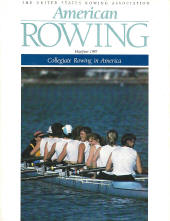 |
The premier
rowing magazine in the country at the time, American Rowing, with the
UW women's varsity eight featured on the cover of the May/June 1987 issue.
The photo was taken after the victory in the Whittier Cup at San Diego in
April, bow to stern: Linda Lusk, Katarina Wickstrom, Fritzi Grevstad, Sarah
Watson, Heidi Hook, Lisa Beluche, Alice Henderson, Kris Sanford (stroke) and
Trish Lydon (cox). In the "Collegiate Rowing in America" featured article inside, five schools are represented: the UCSB women's team; Stanford's women's team; the Purdue men's club team; the Brown men's varsity team; and the Washington women. The Washington section, written by athletes Karen Boone and Julie Gardiner entitled "Commitment, Pride, Tradition", is a well-written contribution that expands on the effort ("no one is cut from the team; hard work and regular attendance are the only requirements") and expectations at Washington. "At Washington, we receive generous support from our athletic department, the community, and the Seattle media", the writers note. And a snapshot into the rower's life in 1987: "At Washington, there is a certain level of excellence and dedication that is expected of all rowers, from the varsity eight through the novice class; selections are based on the survival of the fittest. Intrasquad competition begins with pair trials in the fall, a race against the clock over a 3,500 meter course that determines the boats that will compete in the autumn regattas. The competition continues throughout the winter with erg tests, timed runs, weight-lifting contests, and "Ham and Eggers" (randomly drawn lineups that race 2,000 meters for the "prized" t-shirts)." "Turn outs are held in the afternoons during fall and winter quarters and at 6:00 a.m. during the spring term. Bob often lightens up the mood at the half way point of particularly arduous practices by letting a rower tell a joke or making each boat perform a "boat trick". Some of the more spectacular boat tricks are pushups on the gunwales or balancing the oar with one foot while standing up. Bob is also a believer in alternative rowing workouts which may be anything from swim meets to snow soccer..." The article finishes with the following passage that so well sums up the timeless values (hard work, team over self, camaraderie, row to win) of the program built over time: "In writing about the Husky Team, it would be unfair to leave out the contributions made by the coaching staff, mainly Bob Ernst. Bob is the foundation of Washington Crew; he built it and maintains it. He is an innovator and a motivator who thrives on competition and winning and instills those traits in all of his teams. Bob is a master technician and is able to detect the most subtle flaws in someone's stroke. He assumes an uncompromising level of excellence and anything less 'just isn't good enough'." "People decide to row at Washington for many different reasons... each member works to make the team better and stronger. This dedication enhances the performance of the team as well as the pride and tradition surrounding Washington Crew. A tradition we hope to perpetuate." Paul Semonsen photo, USRA; Added 10/22 |
|||||||||||||
|
||||||||||||||
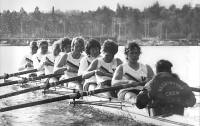 |
1987 Women: “On a
Mission” to the National Championship The 1987 women's squad was coming off a rare and disappointing loss at the National Championships in 1986; Washington had swept the varsity event for five straight years – a streak that still stands as the longest in the history of women’s rowing. Every program in the nation had been gunning for Washington for years, and when Wisconsin prevailed in the final that June day in 1986, the question on everyone’s mind was – “is the dynasty dead?” Not quite. To say the team re-committed itself early that year is an understatement. “We were on a mission,” said Kris Sanford, ’87 varsity stroke (and former women’s head rowing coach at Syracuse). “The year before we were a very young team. We had T-shirts that said ‘Remember We’re Young’. Coach Ernst said he never wanted to see those again.” The ’87 varsity was tested in their first race at San Diego, but powered through the defending champion Badgers to win by a half-length, boosting team confidence. Two weeks later, after sweeping the Redwood Shores event over Harvard and Princeton, the team was poised for greatness. “We were so incredibly up for that race,” said Sanford, “it felt like the weight of the world was lifted off our shoulders. That was a pivotal point in our season.” Meanwhile, not so subtly, the 2V8 was cruising. By the middle of May, the crew had won every race entered by open water, and became Pac-10 champs by stroking to an eighteen-second victory over the closest competition. “We did pretty well against the varsity in training, and felt we were talented”, said Stephanie Doyle, coxswain of the 2V. “From the first day of October, everyone on the team knew we were not there to have fun: we were there to avenge. The one goal we had together as a team was to be first across the line at Nationals.” On the last day of May, that goal would become reality. The Varsity four began with a one-length victory over runner-up Princeton. The 2V8 followed with a gut wrenching four-seat win over Yale. “We were untested in the sprint,” said Doyle “and we ended up rowing neck and neck down the course. I remember ending that race and feeling like I hadn’t taken a breath the whole way.” That left the Varsity. In their heat the day before, they were forced to row through Harvard in the sprint, after being down by a length early. In the final it was déjà vu, only this time both Yale and Harvard charged ahead. But in the end, the fit and intensely determined Huskies powered through the east coast schools to win by a half-length. “I think that is what distinguished that team,” said Sanford. “There was never any fear whether or not we could come back in a race. We just knew we would. They had that quality.” Bob Ernst, who coached the 1987 women’s team, reflected on that season. “1987 was the perfect storm. The team was committed to getting better. Lake Natoma felt like our home course. We had a lot of good athletes. And they really wanted to win.” From the first day of October. Photos: The 1987 V8 (top two photos) and the 2V8 (lower photo) on picture day. UW Rowing photos |
|||||||||||||
 |
||||||||||||||
 |
||||||||||||||
|
||||||||||||||
 |
Jan Harville - a pioneer of Washington Rowing in
the early 70's, two-time Olympian in the 80's, and highly successful UW
women's novice coach from 1981 - 1987, took over the helm of the Washington
Varsity Women's Team in the summer of 1987, replacing Bob Ernst as he moved
to the men's team. In an interview years later, Harville shared the core values of Washington Rowing she sought to teach her athletes: "Work hard to improve every day. Demand excellence. Fight until the last stroke. Support your teammates. The essence of rowing at Washington has stayed the same - it is the ultimate team sport. It’s your determination, toughness, and perseverance that is at the heart of it all.” UW Rowing photo |
|||||||||||||
|
||||||||||||||
 |
From Transition to
Triumph – The Story of the ’88 Women The alarm clock went off at 3:30 a.m. Eastern time (12:30 a.m. Seattle time). Monday morning, June 6th, 1988. Time to race for a National Championship. For the women of Washington, it was just another adjustment. They had spent most of the year getting up in the dark and practicing at dawn, why not race in it? The 87/88 season was a year of adjustment for Washington as Bob Ernst – the coach behind the historical run of women’s National Championships – would turn his focus to the men’s squad. Jan Harville, the ‘80 and ’84 Olympian and women’s novice coach since 1981, was elevated into the women’s head coaching role. “It’s not just a job, it’s a lifestyle” she said to the Seattle P-I in 1988, “It’s what I want to do. I’m lucky”. In her first year as head varsity coach, she joined a veteran team coming off of a historical National Championship sweep in 1987. Stephanie Doyle was the senior varsity coxswain in 1988, and working under the new coach was an easy transition: “Once we all got over the shock of it“, said Doyle, “it united us even more because we had someone joining us who we knew. We had pursued success together before. Jan and I met every day, as we were all trying to preserve and protect the tradition and culture that was built into that program.” “I knew Jan was a great coach and had the experience… I wasn’t worried at all,” said Trudy (Ockenden) Taylor, bow seat of the V8. “You knew where you stood. There was no drama.” Jan echoed that sentiment right back to the athletes. “I had coached the freshmen for seven years and felt like I was walking into a situation with great athletes,” she said. “Bob (Ernst) was a great mentor and talked me through a number of challenges along the way. We were all working within the system that he created.” “There was pressure on everyone. They (the V8) were favored everywhere they went, so it was different from 1987. They had a target on their back and they knew it, but the personality of this team was one of strength and confidence. The experience and trust they had within that team helped them maintain their focus.” The mid to late 80’s saw many of the east coast universities re-building their women’s programs. Wisconsin, in 1986, had knocked Washington off of the top spot on the podium for the first time since 1981. The team was forced to re-group, and the result was an expectation of performance that was visible each day. “When it is that clear, when it is something people share, everyone is on board…” said Doyle, “those women were not going to let one stroke go by that they did not pull their hardest and row their best. It was a standard of excellence I had never seen before.” The varsity eight would proceed through the spring season undefeated, but the competition was fierce. At the Redwood Shores match-racing regatta in April, the team would face down Radcliffe (Harvard), Yale and Brown in three separate races, and in each case were tested the full 2k. Taylor remembered the trust and confidence she had in her team: “We were behind to Brown by a length at the 1500 meter mark. None of us cared where we were because we knew we would win. My biggest take away from that year was the confidence our team had – we were so amped up in the last 500 we could beat anyone.” By the time Nationals rolled around the team had perfected both their race strategy and their physical conditioning, and knew they were on the cusp of meeting the expectation they had set at the beginning of the year. But the stormy weather at Hammond Lake, in the upper reaches of Pennsylvania, had a different agenda that June weekend. On a windy Sunday, when the Varsity finals were set to go, there had been enough swampings and near sinkings in the earlier races that regatta officials cancelled the marquee V8 event. It was agreed that the race would be postponed to Monday, but due to flight schedules and concerns for more bad weather it was going to need to be early. And early it was. “We got up at 3:30 a.m. It was dark when we were stretching,” said Taylor. “and it was dark when we went to launch.” Doyle remembers the same, but with a twist: “It was very peaceful. Contemplative and serene. And then suddenly Radcliffe showed up and started blaring music from their van. I just remember thinking ‘Bring it on.’” Bring it on is what Washington delivered. Out of the blocks in a flash, the Huskies held the lead through the first 1500. “We were in Jane’s Friendship (the 1984 US Olympic Empacher named for the late Jane McDougal ‘82 and donated by longtime UW Rowing Steward Hunter Simpson). We were ahead and I remember feeling in control, and in the last 500 we poured it on. Yaz was in that race… I remember her voice so distinctly,” said Taylor. Yaz remembers that day too. As the senior coxswain for the Wisconsin Varsity 8, she was at the starting line that morning as well. “We knew Washington was the team to beat,” she said. “They were big, fit, and looked confident.” Even so, as the only team to beat Washington at the National Championships since 1981, Wisconsin figured they had a shot. “We held with them through the first 1500 meters… but coming into the last 500 the UW just started walking. Nothing appeared to distract them. As a coach now I can tell you that team was a product of high performance coaching. They had been trained all season for that moment and nothing was going to stop them.” “We finished and there were no fans,” Doyle said. “No one was there. Our parents had all left on Sunday. We got off the water and hugged each other. Jan had a smile from ear to ear.” “I give full credit to that crew,“ said Harville. “It felt like racing in the middle of the night. It was pitch dark when we got to the course… it was not right. But you train for the unexpected… to be ready for anything. And we got it. And they just went out there and took care of business in the biggest race of the year. We won the team championship that year as well, so all around it was an exceptional group of women.” Thirty years later those same women still highly value their experience at Washington. “It was one of the most profound experiences of my life,” says Taylor. “I had never been on a team before that was that dependent on your teammates. I learned so much about discipline, dedication and hard work.” For Doyle, when asked what Washington Rowing has meant to her, she said, “Excellence, and what it means to truly want it. I continue to attempt to live by that idea on a daily basis. It instilled that as part of my being to this day.” Excellence, dedication, confidence… all words that describe the women of 1988. Throw in the ability to adjust to a dawn start for the biggest race of the year… and you have the makings of a champion. |
|||||||||||||
 |
||||||||||||||
 |
||||||||||||||
|
||||||||||||||
 |
The 1989 2V8 on Lake Wingra (Wisconsin) on their way to the National Championship. UW Rowing photo | |||||||||||||
|
||||||||||||||
 |
The 1990 Varsity with the late Jean Laframboise at the 1990 shell dedication in her honor. The Lafromboise family has, for decades, supported both the men's and women's programs at Washington, with Jean and family being early benefactors in the rebirth of the women's program at Washington going back to the 70's. UW Rowing photo | |||||||||||||
|
||||||||||||||
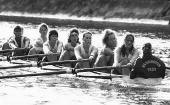 |
The 1991 Varsity 8 at the National Championships. UW Rowing photo | |||||||||||||
|
||||||||||||||
 |
Coaches Bob Ernst, Eleanor McElvaine, and Jan Harville keep the Huskies in focus at the San Diego Crew Classic in 1992 while the women, led by the Varsity 8 seen here on picture day, swept the regatta. UW Rowing photo | |||||||||||||
|
||||||||||||||

|
The 1993 men's and women's V8s together in San Diego after taking the two Varsity marquee events (Copley Cup and Whittier Cup), the women sweeping the regatta for the second time in a row with victories in the V8, 2V8 and Novice 8 events. Lower photo: the women's V8 on Lake Union on picture day. UW Rowing photo | |||||||||||||
|
||||||||||||||
 |
The 1994 2V8 Women's National Champions winning the Callow Cup on Lake Harsha in Cincinnati, bow to stern: Meredith Arnold, Amanda Wilcox, Kathy Colin, Megan Rider, Trista Patterson, Katie Maloney, Jody Broadie, stroke Liz Tuttle and coxswain Joslyn Howard. "The fact the JV boat is strong speaks well for the overall solidity of our program," said coach Jan Harville following the win. UW Rowing photo | |||||||||||||
|
||||||||||||||
 |
The 1995 San Diego Crew Classic Whittier Cup Champions... for the fourth year in a row. Left to right: Hana Dariusova, Amy Piper, Katie Maloney, Ellen Park, Tristine Glick, Ardath White, Babette Siebold, Liz Tuttle with coxswain Joslyn Howard. UW Rowing photo | |||||||||||||
|
||||||||||||||
 |
The christening of the new shell
The Richard Erickson, a fitting tribute to a coach who, like Hiram Conibear,
had a major influence on the (re)birth of women's rowing at Washington. Dick
was the Rowing Director at Washington when Title IX was ratified in 1972,
and it was under his purview that the shellhouse was first shared with the
women beginning in 1975. By 1980, he was actively encouraging his
highly successful freshmen coach, Bob Ernst, to take over the women's
program, and from that point forward the women's team never looked back,
reeling off a still historically unmatched five National Championships in a
row.
A 1958 graduate of the UW (and member of the '58 team that defeated the Soviets in Moscow), Dick went on to earn his graduate degree in Education at Harvard, all while coaching (and training) at MIT in Boston. A highly intelligent, curious, and free-thinking evangelist for Washington Rowing, Dick was cut directly out of the same mold as Conibear, and his dedication to the growth and success of the women's program reflected it. Here he stands with the women of Washington in 1995, with his mother and wife Irma. UW Rowing photo |
|||||||||||||
|
||||||||||||||

|
The 1996 Varsity 8 takes a hard-fought Windermere Cup victory over the Russian National Team and Yale on the Montlake Cut, from the stern: Erin O'Connell, coxswain, Kari Green (stroke), Katie Maloney (7) and Tristine Glick (6); while the 2V8 holds the Cascade Cup aloft left to right: Jen Premselaar, Annie Christie, Gretchen Batcheller, Mona Fong (cox), Heather Webb, Kate Maurer, Carrie Youngberg, Jennie Bingham, and stroke Jody Broadie. UW Rowing photos | |||||||||||||
|
||||||||||||||
 |
The 1997 National Champion Varsity 8 rowing the Dick Erickson, at the inaugural NCAA sponsored Women's National Rowing Championships, left to right: coxswain Alida Purves, stroke Sabina Telenska, Denni Nessler, Kelly Horton, Katy Dunnet, Annie Christie, Jan Williamson, Tristine Glick, and Kari Green. This V8 - undefeated through the season and dominant - won the grand final by open water. "I feel absolutely great," said coach Jan Harville after the race. "It really couldn't be better. To win by open water and to walk away like that... you don't even dream about that." UW Rowing photo | |||||||||||||
 |
The 1997 NCAA Team Champions: silver in the V4+; silver in the 2V8; and gold in the V8. "We worked so hard for so long and it finally all paid off," said 2-oar (and the only senior in the V8), Tristine Glick. UW Rowing photo | |||||||||||||
 |
"You never know how a race is going to turn out," said Jan Harville, here embracing assistant coach Eleanor McElvaine after the final. "But I've probably never had more confidence in a crew I've coached. You knew they were going to perform. You knew they were going to be on." UW Rowing photo | |||||||||||||
 |
"We could respond to any challenge'" said Tristine Glick, seen here (lower left corner) swimming in Lake Natoma with her teammates holding the first NCAA team trophy won by any team in any sport at Washington. "I think that was the best thing about our boat - we're all a bunch of racers and we just love to race. And nobody was scared of anybody." UW Rowing photo | |||||||||||||
|
||||||||||||||
 |
With Brown and Washington tied at 43 team points each heading into the 1998 NCAA V8 Final, the varsity blasted off the line to lead by a half-length in the first 250m, powering down the Lake Lanier course to win the Varsity 8 National Championship by a length over Massachusetts and Brown, sealing the NCAA Team victory for the Huskies for the second year in a row. "That race was one of the very few races that felt like it was perfect from the beginning," said Varsity coxswain Melissa Collins. "We were in control of our race the whole time. Every time I called a move they would respond. The goal was we were going to row our own race and not worry about anyone else and that's exactly what they did. That boat - and that race - were amazing..." Bow to stern: Kari Green, Vanessa Tavalero, Rachel Dunnet, Annie Christie, Katy Dunnet, Kelly Horton, Denni Nessler, Sabina Telenska (stroke), and Missy Collins (cox). UW Rowing photo | |||||||||||||
 |
The 1998 NCAA Team Champions. "The 1998 team had a lot of pressure to repeat in 1997", said Varsity coxswain Melissa Collins, "but they were so determined to go as fast as they possibly could with a common, clear goal all year... and were absolutely committed to it." UW Rowing photo | |||||||||||||
 |
The 1998 varsity with the V8 trophy... | |||||||||||||
| ...followed by Collins with the victory bath. "It was the best feeling in the world," said Collins. UW Rowing photos | ||||||||||||||
|
||||||||||||||
 |
The 1999 NCAA Champion V4+, left to right: Erin Becht (stroke), Anna Mickelson, Kara Nykriem, Kellie Schenk (bow) and Mary Whipple in the bowrider cox position. Every one of these athletes was a freshman in 1999. UW Rowing photo | |||||||||||||
 |
The 1999 NCAA bronze medal team with a gold in the V4+, 4th in the 2V8 and 5th in the V8. UW Rowing photo | |||||||||||||
 |
A familiar scene on shore as the team rallies the V8 in the Grand Final. UW Rowing photo | |||||||||||||
|
||||||||||||||
 |
The 2000 NCAA Team silver medalists, including the National Champion 4+ (like 1999, all frosh) and silver medalists in the V8 and 2V8. It was a powerful Brown squad that took home the team trophy in the winner-take-all Varsity final. UW Rowing photo | |||||||||||||
|
||||||||||||||
 |
The Henley Royal Regatta's featured women's eight-oared event was introduced as the "Henley Prize" in 2000 (later to become the Remenham Cup). Washington's Varsity 8 was invited, and opened the regatta with a win over the University of Virginia (by 2 lengths), followed by a stunning victory by a quarter-length over the University of London (a composite British National Team) in the semi. On July 2nd in the Grand Final, the team defeated the University of Victoria (a composite Canadian National Team) by a half-length to win the inaugural event in one of the most exciting races at Henley in 2000. Pictured bow to stern: Nicole Rogers, Rika Geyser, Lindsey Horton, Anna Mickelson, Vanessa Tavalero, Theresa Nygren-Birkholz, Nicole Borges, Sabina Telenska (stroke) and Mary Whipple (coxswain). | |||||||||||||
 |
"This was an awesome race," said head coach Jan Harville of the grand final, the team pictured here in front of the enclosures. "We were ahead at the first marker (Barrier) by a foot. At the second marker (Fawley), Victoria was ahead by a foot... and then we went up again. I told our crew that Victoria had a fast boat and we would have to take the race away from them. We did it in the last 500 meters of the race. I am so proud that our team could end the season in this way... it was a tremendous opportunity to be here and represent the University of Washington." | |||||||||||||
 |
The Huskies moving in the last 500 meters of the Grand Final to take the inaugural Henley Prize (Remenham Cup) July 2nd, 2000. | |||||||||||||
 |
The 2000 women gather together prior to taking the medal stand at Henley. UW Rowing photo | |||||||||||||
|
||||||||||||||
 |
The 2001 Varsity 8 across the line by about a deck in a headwind on Lake Lanier in 7:04.03; Brown in second in 7:05.34; and Michigan for the bronze in 7:08.45. "In the last 500, our coxswain, Mary Whipple, did an excellent job," said senior Nicole Rogers. "She said 'let me take you guys home. Listen to me. It's going to get creative.' She started calling us up and we all went together. Once we started moving, we knew. She kept calling 'believe, believe, believe' the whole time. When she called 'believe', we did and we just went." UW Rowing photo | |||||||||||||
 |
The 2001 V8 on the podium, left to right: Annabel Ritchie, Nicole Rogers, Carrie Stasiak, Adrienne Hunter, Rika Geyser, Anna Mickelson, Nicole Borges, Lauren Estevenin (stroke), and Mary Whipple (coxswain), with head coach Jan Harville. A quick start put this team in the lead through 500m, but Brown put on a move and kept a 2-3 seat lead through the body of the race, the Huskies only pulling through in the last 150m to take the win. "The crew said it was pretty rough," said Coach Harville. "It wasn't pretty. They won it on guts. It was an outstanding performance." UW Rowing photo | |||||||||||||
 |
The 2001 NCAA Team Champions. UW Rowing photo | |||||||||||||
|
||||||||||||||
 |
Windermere Cup 2002: Mary Whipple is shouldered to the lake by teammates Yvonneke Stenken, Anna Mickelson, and Kara Nykriem after the open water V8 Windermere Cup victory over Stanford and Great Britain. WRF photo | |||||||||||||
 |
The 2002 Pac-10 Champion 2V8, open water victors in an absolute downpour on Lake Natoma, and ultimately the NCAA 2V8 National Champions in a comeback win for the ages over Brown. Front row: coxswain Anne Hessburg, stroke Jenni Vesnaver, Shannon Oates, Jessica Harm; back row: Erin Becht, Sanda Hangan, Marghe Pallotino, Erin Curry and Mandy Nelson. The Huskycrew full coverage of 2002 is here: 2002 Race Results. WRF/Oates photo | |||||||||||||
 |
The 2002 NCAA National Champion Varsity 8 on the Indianapolis Eagle Creek course, left to right: Mary Whipple (coxswain), Lauren Estevenin (stroke), Annabel Ritchie, Anna Mickelson, Heidi Hurn, Adrienne Hunter, Carrie Stasiak, Kara Nykreim, and Yvonneke Stenken. "When we got off the plane last night we were equally as excited as last year when we won the team championship," said Anna Mickelson. "Last year we wanted to take the title from Brown and we did. This year we had our junior varsity team win for the first time since 1994. We're just really proud of what we did." UW Rowing photo | |||||||||||||
 |
The V8/2V8 sweep was the first for
Washington since the NCAA began sponsorship in 1997 (and the first since
1987 for Washington), and although Brown would win the team title based
on their win in the V4+, Jan Harville was philosophical when it came to her
team taking second: "They may
go home with the trophy this time," she said, "but I'm not going to trade
two wins for that. The Brown coach and I congratulated each other. It's a
little bizarre, but we knew it might happen like this." UW Rowing photo
|
|||||||||||||
|
||||||||||||||
 |
The
caption from the
2003 Race Results page
of this photo from the UW/Cal Dual Regatta: "The women's Varsity event was a
ferocious race by both clubs - a classic duel down the entire length of the
course. Both teams still had good speed as they entered the sprint, with
Washington beginning to pull away at the end. A terrific collegiate boat
race of two exceptional crews: Varsity Eight -- 1, UW 6:41.9. 2, Cal
6:44.6."
The V8 lineup: cox Anne Hessburg, Lauren Estevenin, Carrie Stasiak, Adrienne Hunter, Heidi Hurn, Jessica Harm, Erin Curry, Mary Reeves, Yvonneke Stenken. HRF photo |
|||||||||||||
 |
The team with the 2003 NCAA Team Bronze trophy, the V8 taking 4th; the 2V8 taking 2nd, and the V4 finishing 7th overall. UW Rowing photo | |||||||||||||
|
||||||||||||||
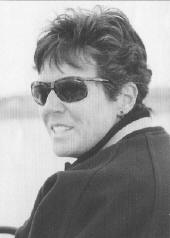 |
Jan Harville,
after coaching at Washington for 23 years, stepped down as women's head
coach in the summer of 2003. "I've been thinking about it for a couple of
years. I never dreamed that I would even coach this long," Harville said.
"Coaching for me is something that has been a full-time passion and lately
it takes more and more energy to create the passion needed to be 100
percent." Jan accomplished a number of first's while at Washington: she was the first Women's US National Team member to come out of the UW program (while it was still a club sport) and a two-time Olympian; the first female head rowing coach at Washington (1987); the first coach to win an NCAA championship at Washington (all sports) and the first female rowing coach (nationally) to win a Team National Championship (1997) and the first to win a Women's major Henley event (2000). She left the UW with 3 Team NCAA titles, 11 National Championship crews and 41 Conference champions. "I've been fortunate to be associated with rowing at the University of Washington," said Harville. "We celebrated the centennial of rowing at Washington this year (2003) and I really appreciate the tradition and history of the program. Coaches at Washington feel that we're kind of caretakers for the program for a period of time. That's a lot of responsibility." Eleanor McElvaine, Jan's highly successful Frosh coach since joining the staff in 1987, was announced as the new UW Women's Head Coach later that summer, and would take over the program beginning in the fall of 2003. Photos: UW Rowing and HRF: hat tip to source Dan Lepse from GoHuskies in 2003 |
|||||||||||||
 |
||||||||||||||
|
||||||||||||||
 |
The 2004 V4+ winning the Pac-10 Championship on Lake Natoma (and would later win silver at the NCAA's), left to right: Eva Anderson (cox), Alina Tabacaru, Signe Johannes, Analena Sepherd, and Katherine Ramos. Full coverage of the 2004 season is here: 2004 Race Results. Photo thank you Buckland family/WRF | |||||||||||||
|
||||||||||||||
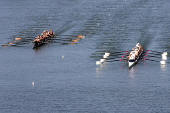 |
The 2005 V8 over Texas at the Windermere Classic on a sunny Redwood Shores course In April. Full coverage of the 2005 season is here: 2005 Race Results Photo: thank you Sean Mulligan | |||||||||||||
|
||||||||||||||
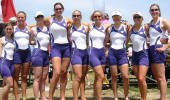 |
The Varsity 8 at the 2006 NCAA's left to right: Ava Anderson (cox), Courtney Plitt, Jamie Unwin, Sarah Hubbard, Kim Armstrong, Megan Kalmoe, Allison DePalma, Olivia Morrow, and Marah Connole. Full coverage of the 2006 season is here: 2006 Race Results Photo: thank you Mary Whipple | |||||||||||||
|
||||||||||||||
 |
The class of '07 together on Class Day - left to right: Andrea Smith, Liz Simenstad, Corianne Bowman, Kristy Gauthier, Cara Troelstra, Courtney Plitt, Asiha Grigsby, Victoria Gibson, and Andrea Sooter. HRF photo | |||||||||||||
|
||||||||||||||
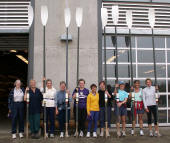 |
On
April 7, 2007, the University of Washington presented Varsity Letters to
female athletes (all sports) that competed prior to 1975 (pre-Title IX) and
would have earned Letters under current requirements, in a formal dinner and
ceremony at the Bank of America Arena on campus. The major event -
including individual introductions and award presentations - celebrated over
300 athletes, including more than thirty UW rowers. "Prior to Title IX, a
lot of things were not very formal, so the records kept were hit and miss,"
said Ann Higgins, an assistant to senior associate AD Marie Tuite. "That
became one of our other goals - preserving the history of the women of
Washington." Angie Mentink, UW All-America softball player in 1994, FSN sportscaster and master of ceremonies for the event said, "I don't have any stories of sleeping on floors or anything like that. Because of them, I don't," she said. "We were stinking spoiled, so I have no stories like that at all." Mary Schutten, one of the event organizers and a tennis player at the UW in the mid-70's added, "I want to honor and understand the history. We stand on all those women's shoulders and it wasn't easy. These were my athletic emancipators. At the very least, they deserve this night and our thanks." Pictured here are some of the pre-Title IX Washington Rowers who were honored and awarded at the event, and then took a spin on Lake Washington in celebration. WRF Photo/Thank you sources Athletic Business and The Seattle P-I |
|||||||||||||
|
||||||||||||||

|
The 2007 V8 over OSU on the Cut in April bow to stern: Liz Simenstad, Kim Armstrong,
Samantha Smith, Andrea Sooter, Kim Kennedy, Taryn Langlois, Jamie Unwin,
Cara Toelstra (stroke) and Alysha Koorji (coxswain); that same photo became
the cover of the 2008 UW Rowing Media Guide one year later. Full coverage and many more photos of the 2007 season are here: 2007 Race Results. HRF photos |
|||||||||||||
|
||||||||||||||
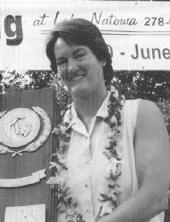 |
In July of 2007, Bob Ernst stepped down as the Washington men's head coach, only to step up to once again lead the Varsity Women's program at Washington, a position he held from 1980 through 1987. He replaced long-time women's coach Eleanor McElvaine, a committed athlete and coach at Washington for over twenty years. In her coaching career, Eleanor's teams won multiple conference and national championships as assistant to Jan Harville, before moving into the head coaching role in 2003. A Washington Hall of Fame member, Eleanor was a mainstay in the six-seat of the varsity eight from '83-'85, winning three straight National Championships. "I have the utmost respect for Eleanor, who has put an indelible stamp on the Husky program both as a student-athlete and coach" said Athletic Director Todd Turner. With this change, Ernst became the first D1 rowing coach in history to move from the men (1974-1980) to women (1980-1987) to men (1987-2007) and back to women (2007-2015), coaching multiple National Championship teams along the way, including NC sweeps with the women (1987) and the men (1997), and an Olympic Championship in 1984 with the USA Women's 8+. Listen: Bob Ernst talks about the 2007 coaching transition, and his new role as Women's Varsity Coach (4 min, mp3) |
|||||||||||||
 |
||||||||||||||
|
||||||||||||||
 |
Jennifer Park and Maggie Cheek celebrate the 2008 NCAA V4+ victory after holding off Virginia in a ferocious race on Lake Natoma; Washington 7:24.75; Virginia 7:26.09; Brown 7:29.77. Brian Jackson/HRF photo | |||||||||||||
 |
The 2008 team came out of nowhere at the NCAA's,
surprising just about everyone but themselves in taking the Team Silver.
From the
2008 Race Results
page, some of the interviews we did following this exceptional performance (Interviews:
Eric Cohen; Photo: Brian
Jackson/HRF):
Bob Ernst: "The kids rose to the occasion - every single player did her best. Everybody had a great weekend...everybody - everybody - on this team rose up to their potential this weekend...these kids just deserve a mountain of credit." audio-video\ernstncaa6-1-08.mp3 Ashley Jones, Senior Captain: "Washington Rowing is like nothing I have ever experienced before... I wouldn't give up any of it for anything and I feel very honored to be a part of such an amazing tradition..." audio-video\ajncaa6-1-08.mp3 Isabelle Woodward, Sophomore V8 coxswain: "Yea, Well, being part of this team, we don't quit. None of our boats quit. You saw all of us walk back today. That is what Husky Rowing is about. We never quit, we never give up..." audio-video\isabellencaa6-1-08.mp3 Charlene Franklin, Senior 2 Seat of the V4+: "We really were focused on relaxing and racing our own race. When we got passed by Virginia around the 1000 we didn't let it get to us, we knew we would get it back, and we had an awesome sprint..." audio-video\charlenencaa6-1-08.mp3
Colin Sykes, coach of the V4+, talks about
the race and the 4+ athletes: "They
rowed a lot of the piece at a 32...you knew they would have the gear if they
had contact at the end, and they did. They really put a lot of heart into
it, I'm really super proud of them because they had to dig deep to get it,
and when they were through they had really gone to the tank. I explained a
lot to the four about the people that go before them and how much support is
behind them and the alumni....they were out there representing us. It's a
big thing for them. They really wanted to make a statement. It is a fun,
great group to coach - they are really focused - and that made my work
easy." Full interview (2:30 min) here
- audio-video\colinncaa6-1-08.mp3 |
|||||||||||||
|
||||||||||||||
 |
Mary Whipple (left) and Anna
Mickelson (right) celebrate as Olympic Champions in the USA Women's 8+ at
the 2008 Beijing Olympics. Classmates at the UW (class of '02), Mary and
Anna went from the NCAA National Champion V4+ as freshmen to the Varsity 8
for the rest of their careers... which went like this: 2000: NCAA V8 silver
and Henley Prize (Remenham Cup) Champions; 2001: undefeated NCAA V8
Champions; 2002: undefeated NCAA V8 Champions. Together they went on to the
US National Team where - as mainstays in the USA Women's 8+ - they reeled
off the following: a World Championship together in 2002; an Olympic silver
medal in 2004; another World Championship in 2006; and capped it off with
this Olympic Championship in 2008. Anna would retire after 2008, but
Mary would stay on through 2012 (continued below). One more thing:
Anna Mickelson never rowed before her first day at Washington - training in
Old Nero - as a feshman walk-on rower.
Here is what Anna had to say about her experience with Husky Crew when interviewed in 2008 prior to the Olympics: Anna Mickelson '02 and Washington Rowing (audio mp3 file, 3 mins): "I vividly remember getting my first unisuit… and to be a part of all of the pictures I had seen on the walls at the boathouse and to be a Washington Husky… it was so amazing, we were now a part of this bigger thing. To be a part of something like that - once everyone puts all of themselves into it and you’re part of that - then you become something bigger than yourself, which is more powerful than you by yourself, and you can accomplish great, great things." |
|||||||||||||
|
||||||||||||||
 |
Fast-forward 24 years from 1984, and the Simpson family stepped up once
again to provide the golden touch to the USA Women's Olympic Team,
delivering The Hunter to the '08 Team - a team that would go on to
win the gold in Beijing (see above). And as in 1984, the shell arrived back
home to Seattle to become the Washington Women's Varsity 8 shell. It all
started in the fall of 2007, when Brooks Simpson ran into Bob Ernst at a
football tailgate; Brooks remembered that in the course of conversation, "I
asked him, 'Can you still get a shell to the Olympics?'" Ernst said he
thought he could. Brooks continued, "It just kind of fell in
place. As was the case before, the shell comes home. It will be the (UW's)
number one shell while it's competitive." On March 28th, 2009, The Hunter was inaugurated with the help of ten returning Washington Olympians, seen here with the 2009 Varsity. More on The Hunter and the celebration at Washington is here: The Hunter HRF photo; thank you source Seattle P-I |
|||||||||||||
|
||||||||||||||
 |
The Juniors, (pictured here left to right: Adrienne Martelli, Alison Browning, Jenny Park, and Erika Shaw) with the Seattle Times trophy on a wet and wild 2009 Class Day. The first women's Class Day took place 100 years before this celebration (Washington Rowing History - Women: 1900 - 1909), this photo capturing the significance and meaning - and the fun - of this long-standing tradition at Washington. HRF Photo | |||||||||||||
 |
The 2009 2V8 out of the gates strong in their semi, finishing 2nd in a gut-check and advancing to the final where they would finish 5th, helping to solidify a 7th place team finish (substantially higher than their seeding) in the strongest field at the NCAA's since inception. More on the 2009 season is here: 2009 Race Results. HRF Photo | |||||||||||||
|
||||||||||||||
 |
Erin Lauber putting the hammer down at the 2010 Pac-12's in the V8. HRF Photo | |||||||||||||

|
The 2010 team rowing in some famous shells: Haley Yeager, bow seat of the 2V8 rowing the Jan Harville to victory over Wisconsin in the UW/Wisconsin Dual Race, and the Pac-12 Champion novice team in the simply named Hunter, the namesake of longtime friend and steward of the women's program at Washington, Hunter Simpson. More on the 2010 season is here: 2010 Race Results. HRF Photos | |||||||||||||
 |
The 2010 Women's alumni row on Class Day weekend. HRF Photo | |||||||||||||
|
||||||||||||||
 |
Two early season 2011 wins at the San Diego Crew Classic, the Novice 8 front row, and the 2V8 in the back. More photos and full coverage of the 2011 season is here: 2011 Race Results. Katie Gardner/HRF Photo | |||||||||||||
 |
The 2011 Windermere Cup Champion V8 with an open water victory over Oklahoma and Cambridge, bow to stern: Veronica Tamsitt, Kirstyn Goodger, Kira O'Sullivan, Leslie White, Madison Culp, Kerry Simmonds, Erin Lauber, Camilla Sullivan (stroke), and Ariana Tanimoto (coxswain). UW Rowing photo | |||||||||||||
|
||||||||||||||
 |
The 2012 Varsity 8 at the NCAA's left to right: Fiona Gammond, Kirstyn Goodger, Erin Lauber, Skye Pearman-Gillman, Kelsey Jackson (cox), Madison Culp, Marie Strohmeyer, Ruth Whyman, and Amy Fowler (stroke). More photos and full coverage of the 2012 season is here: 2012 Race Results. Photo: Colin Sykes/HRF | |||||||||||||
|
||||||||||||||
 |
Mary Whipple finished her coxing career in 2012 as a two-time Olympic Champion (2008, 2012), Olympic silver medalist (2004), and 5-time World Champion (2002, 2006, 2007, 2010, 2011). Add to that three NCAA championships and a Henley championship as a UW athlete, and you have the most decorated rower in UW history. “Mary had the rare ability to get eight very strong women all working together," said UW and USA National Team teammate Anna Mickelson. "When you lock into that, the power is something you can’t even quantify.” US Rowing photo | |||||||||||||
 |
The USA Quad after winning the bronze medal in London, featuring Megan Kalmoe '06 (2nd from right) and Adrienne Martelli '10 (closest right). Kalmoe would continue on to the Olympics in 2020 (2021), becoming the first Washington rower, men and women combined, to be a four-time Olympian: 2008, 2012, 2016, and 2020. US Rowing photo | |||||||||||||
|
||||||||||||||
 |
The 2013 Women's V8 in the race of the day at the UW/Cal Dual Race, the crews within a seat throughout the first 1000m, then Washington with a move in the 3rd 500 to take two more seats, the two teams flying into the Cut within a half-length with the Huskies on top, drawing it out in the sprint to win for the first time in nine Simpson Cup races in 6:24, Cal trailing in 6:26.4. UW Rowing photo | |||||||||||||
|
||||||||||||||
 |
Bob Ernst -
whose men's team had taken the trip to New Zealand for the "Gallagher Great
Race" on the Waikato river in 2005 - was invited to bring his women's
varsity back to the event in the summer of 2014 and race for the Bryan Gould
Trophy. On September 15th, 2014 (springtime in New Zealand), the UW women
pulled off the upset over Waikato University and Melbourne University to win
the 4.2k upstream, winding river course on the Waikato River (through
central Hamilton). The New Zealand equivalent of the Windermere Cup - the
community coming together to celebrate the storied New Zealand sport and the
competition - the Great Race is a wonderful event with gracious hosts that
make it that much more special. From the Waikato University article on
the race: "Waikato University, led by world champion Zoe Stevenson in stroke, made the early running along the east bank in the women’s race, as Washington remained close, with Melbourne dropping back. Washington’s attack forced Waikato to veer into the current as the teams moved to the west bank, where the Americans clipped a tree along the riverbank to drop back by two lengths. When the action returned to the eastern side of the river, the Washington crew attacked again, gaining the overlap to force Waikato back into the current in the middle of the river. It proved the pivotal move as the Americans pushed on over the final 200m to claim an historic victory. “It was perfect execution out there today,” says Auckland’s Kirstyn Goodger, who rows for Washington. “The river was pretty challenging but I thought our coxswain handled it beautifully. The river was going a bit faster and we hit a couple of trees we hadn’t hit before so that was fun. Everything we planned we executed.” Their long-time coach Bob Ernst heaped praise on their coxswain Marlow Mizer. “Most of our races are in swimming pools 1.25 miles long and everybody goes in a straight line. Our coxswain is very young but was a ski racer and so she understands the lines and she was perfect navigating on this river and in the currents today.” The race culminated a week-long activity including indoor rowing, schools visits, corporate, university and schools eights rowing on the Waikato River." Washington's roster for the trip: Kadie Brown, Soph., (Federal Way, Wash.), Maddie Cornder, Grad., (Melbourne, Australia), Allie Delarge, Jr., (Victoria B.C., Canada), Fiona Gammond, Sr., (Bucknell, England), Kirstyn Goodger, Grad., (Auckland, New Zealand), Marlow Mizer, Soph., (Kailey, Idaho), Patricia Obee, Grad., (Victoria B.C., Canada), Grace Spoors, Jr., (Christchurch, New Zealand), Phoebe Spoors, Soph., (Christchurch, New Zealand), Courtney Thompson, Jr., (University Place, Wash.), Elizabeth Vogt, Sr., (Trout Lake, Wash.) UW Rowing photo |
|||||||||||||
|
||||||||||||||
 |
Members of the 2014 Novice 8 (Class of '17) celebrating an undefeated season at the Pac-12's, with a spirit that reflected the improving overall team. Keep an eye on this group of athletes, you will be seeing more of them on the podium over the next three years... UW Rowing photo | |||||||||||||
|
||||||||||||||
 |
Colin Sykes and Bob Ernst in 2014, a coaching partnership that excelled with both the men's and women's teams for twenty plus years through consistency, high expectations, and a commitment to the traditions and unique history of Washington Rowing. HRF photo | |||||||||||||
|
||||||||||||||
 |
The 4th-ranked Washington V8 across the line over 3rd-ranked Virginia in a back and forth barn-burner in front of 50,000 fans at a sun-soaked 2015 Windermere Cup, one of the best crew races down the Cut in the decade. "This young team just keeps growing and getting better throughout the season," said Bob Ernst. "Beating Virginia was a great indicator for us. They are one of the best teams in the country, and to beat them and win the Windermere Cup is an honor." Bow to stern: Liz Vogt, Bella Chilczuk, Dani Olson, Grace Spoors, Phoebe Spoors, Sarah Dougherty, Fiona Gammond, Natasha Gay and coxswain Marlow Mizer. UW Rowing photo | |||||||||||||
 |
"The Washington women fought hard and earned their spot on the podium this year, and all with a fairly young and inexperienced team," said Bob Ernst after the team came home with the 4th Place Trophy from the 2015 NCAA's on Lake Natoma. I am so proud of this team and my wonderful coaching staff - Conor Bullis, Colin Sykes, and Zoe Vais! Our progress has not been straight up over the last eight years, but we are getting there. The NCAA Championship is in sight and our system is 'Built to last'". UW Rowing photo | |||||||||||||
|
||||||||||||||

|
Bob Ernst, seen here in 2015 with the Simpson family (Brooks Simpson, Dottie
Simpson, and Anne Simpson) as they christen the newest Hunter, was relieved of his duties as UW Rowing Program
Director and Women's Head Coach in the fall of 2015. Ernst had coached at
Washington for 42 years, beginning his career as the men's frosh coach in
1974.
Conor Bullis, in a photo from 2008 after coaching the men's V4+ to a National Championship, would assume the women's head coaching duties in December of 2015. Bullis had joined the women's staff in 2012 as the Novice coach, leading the Novice 8 to two undefeated, Pac-12 Champion seasons in 2013 and 2014, before doing the same with the W3V in 2015. HRF photos |
|||||||||||||
|
||||||||||||||
 |
The 2016 women and men together on the Windermere Cup podium, the women defeating Cambridge and San Diego State for their 10th straight victory in the event. The women's V8, front row left to right (not in boating order): Val Vogt, Grace Spoors (stroke), Phoebe Marks-Nicholes (cox), Natasha Gay, Sarah Dougherty, Dani Olson, Katy Gillingham, Calina Schanze, and Phoebe Spoors, with coach Conor Bullis far right. UW Rowing photo | |||||||||||||
 |
The 2016 NCAA silver medalist V4 rowing the
Allegra left to right: Vanessa Whatam, Sophia Dalton, Kadie Brown,
Maggie Phillips and cox Madison Mariani. In the Grand Final, this team
stormed into the lead but were overtaken by Cal in the last 500m. "Their
coach Alan Meininghaus had a plan for them and I think they did everything
they could to execute the best final race," said Coach Bullis. "And boy what
a race. That is what we expect at the NCAA championships." The 2V8 would make the podium with a bronze as well, the V8 unable to make the Grand but overall the team would finish 5th. "I'm really proud of the team as a whole," said Coach Bullis. "It sounds cliché, but top to bottom, the 6V in our boathouse puts pressure on our 5V, to the 5V winning our home races. The 4V and the 3V winning the Pac-12 Championship for the third year in a row. The 2V having an amazing race and the 1V finishing with the best race of the year. That is all you can ask for. I am really proud of them." "We are a product of what we are willing to do for Washington Rowing to push for excellence in all aspects of our program. Our community is strong and able to do such incredible things in rowing and the lives of our student-athletes. I am honored to have been the interim women's head coach during the 2016 season. The team is very strong and has a strong incoming class. The future is bright for Washington Rowing." UW Rowing photo; source thank you Jeff Bechthold at GoHuskies |
|||||||||||||
|
||||||||||||||
 |
Olympic Champions Kerry Simmonds '11 (bottom row, second from left), along with coxswain Katelin Snyder '09 (next to Kerry), with their USA teammates and the gold medals won in the Women's 8+ at the 2016 Rio De Janeiro Olympic summer games. Ed Hewitt/Row2k photo | |||||||||||||
|
||||||||||||||
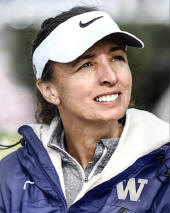 |
In June of 2016, Yasmin "Yaz" Farooq was named
the Head Coach of the Women's Rowing Program at Washington. Bringing ten
years of experience as the head women's coach at Stanford - including an
NCAA Team National Championship in 2009 - Yaz came to Washington with a
built-in appreciation for the program: “I always knew the only place I’d
leave Stanford for would be Washington,” she said. “In so many ways, this is
the birthplace of modern-day women’s rowing, a truly pioneering program.” A National Champion at Wisconsin in 1986 (the team that broke the Washington NC streak at five in a row in the 80's), a mainstay in the USA eight from 1989-1996, a two-time Olympian ('92, '96), three-time World's silver and a World Champion in 1995, Yaz would bring extensive competitive experience, a commitment to hard work, and a coaching style emphasizing team over self and an appreciation for the uniqueness of the sport at Washington. "We have year-round water, a boathouse on campus, training table meals for all the UW student-athletes right here in our boathouse — plus academic resources, training, strength and conditioning, sports medicine, all within a 2-minute walk," she said. "It’s a dream job to coach at a university and in a community that celebrates and supports rowing at such incredible levels." That fall a young team would meet her at the boathouse for the first time, Farooq noting, "They told me they weren’t afraid to work hard and do what I asked them to do. And they desperately wanted to win. They were hungry." How hungry? Hang onto your hat, this ride takes off in three, two, one... UW Rowing photo; source thank you UW Tyee |
|||||||||||||
|
||||||||||||||
 |
At the 2017 NCAA's, Washington would enter the competition as the top seed after sweeping the Pac-12's, the confidence and energy in this team boiling over as they arrived back at Lake Natoma two weeks later for the National Championships. The V8, 2V8 and V4 all qualified into the Grand Finals by winning their semis, setting the team up in the best lanes as the final day began on Sunday. First to cross the line was the V4+ with an open water win over the field in 7:07.1 (Cal was 2nd in 7:11.7), senior Val Vogt with arms outstretched in victory with teammates Valentina Iseppi (left), and Julia Paulsen (right). HRF photo | |||||||||||||

|
The 2V8 with one of the most dominant wins in the history of the NCAA's, with an open water lead by the midpoint and then crushing the field in the 2nd half, finishing in 6:47.3 (2nd place Cal finishing in 6:53.3). Left to right: Isabella Corriere (Cox), Marlee Blue (Stroke), Maggie Phillips (7), Carmela Pappalardo (6), Phoebe Spoors (5), Karle Pittsinger (4), Bella Chilczuk (3), Anna Thornton (2), and Calina Schanze (Bow), along with assistant coach Josh Gautreau. HRF photos | |||||||||||||

|
With Cal finishing second in the first two events, the 2017 team title would come down to the V8: the team that finished in front of the other would take the NCAA Title. Blasting out of the gates it was Washington with a narrow lead at 500m, extending it through the midpoint, then after what seemed like an eternity the race coming into the close with Washington up by about 6 seats... Stanford charging hard now with Cal... but the Huskies holding them off to win in 6:36.9, followed by Stanford in 6:38.5, and Cal in 6:40.1. The varsity, shown here in the Grand Final; and then celebrating the sweep after reaching shore with their teammates, from stern to bow: Phoebe Marks-Nicholes (Cox), Chiara Ondoli (Stroke), Elise Beuke (7), Brooke Pierson (6), Katy Gillingham (5), Brooke Mooney (4), Tabea Schendekehl (3), Jessica Thoennes (2), and Annemieke Schanze (Bow). HRF photos | |||||||||||||
 |
The 2017 NCAA sweep was the first sweep in the history of the NCAA's, and the first Women's National Championship sweep since Washington did it in 1987. "Every single boat executed the race plan perfectly," said Yaz. "It took a lot of courage for them to do that because it required a lot of commitment early in the race that most people would think would be unsustainable. Every one of those boats delivered on all 240 of those strokes in that race." HRF photo; source thank you Jeff Bechthold at GoHuskies | |||||||||||||
 |
"For all the talk amongst competitors about
pushing another crew so hard that you "break them," the toughest warriors
know that first you must triumph over your own fears, over pain, over
adversity", Yaz wrote later about this team. "This creates an inner
conversation, no longer about who you can take out, but about how fast you
can make your own boat go, what you can create together that translates into
rhythm, run and pure boat speed."
She continued, "Women of Washington, you did it. Thank you for dreaming big and following through on your promise to one another. You have added to the legacy. Alums, thank you for paving the way, inspiring us and for all you do to support this team. We are proud to carry on this amazing tradition, one that empowers our student-athletes within the boat and beyond." HRF photo |
|||||||||||||
|
||||||||||||||

|
The christening of the Title IX Sisterhood
on Opening Day weekend, 2018, a collective gift from the women that
pioneered the sport in the 70's. Spearheaded by Linda Cox Fornaciari
(1978 captain, see above), she discussed the background on how they arrived
at the name: "Our group of teammates engaged in a vibrant discussion
about the name for the boat, starting with over 50 suggestions," she
explained. "It became essential to have 'Title IX' in the name, since that
was transformative for our team and women in the '70's. After many emails
and votes, it came down to two names that really resonated with us: 'Title
IX Tenacity', since tenacity is a quality that described us and describes
the team today."
"But we chose the name 'Title IX Sisterhood," she continued, "because of the importance of the bond we shared that we know continues today in the team. We want these incredible women to feel the strong spirit of the women of the '70's carrying them forward in the boat and in all that they do, as part of the rowing sisterhood that we share." HRF photos; source thank you Jeff Bechthold at GoHuskies |
|||||||||||||
|
||||||||||||||

|
The men and women together on the shores of Lake Natoma after a dominant Washington Men's and Women's Team Championship performance at the 2018 Pac-12's, the women sweeping the regatta; and then the women together on the podium as they collect their team trophy, singing Bow Down To Washington, about as appropriate a finish to this championship regatta result as possible. HRF photos | |||||||||||||

|
A raucous and absolutely loaded with talent
2V8 celebrating a commanding win at the Pac-12's, and then two weeks later
as they cross the line with open water as NCAA Champions on the Benderson
Sarasota course in Florida. "The 2V simply dominated the weekend," Yaz said.
"That group has been pushing the varsity eight all year, and it was really
wonderful to see them get to spread their wings here and become National
Champions." Left to right on the podium: Cox: Marley Avritt, Brooke
Pierson (stroke), Katy Gillingham, Carmela Pappalardo, Karle Pittsinger,
Jess Thoennes, Jennifer Wren, Julia Paulsen, and Calina Schanze. The 2018 NCAA's were marked by typical Florida spring weather, a storm forecast for Sunday pushing the semis and finals onto Saturday and adding a major challenge to every team there. Washington faced an improving Cal V8 - these two exceptional teams somehow landing in the same semi together - Cal nosing out the Huskies in the morning and setting the stage for another UW/Cal burner for the final. Then as the weather deteriorated, the officials moved the V8 to the first final of the afternoon, Cal prevailing but only after an all-out effort once again by the Huskies. With the 2V then rowing to their impressive win in their final - underscoring the depth of this Washington team for the 4th year in a row - it was down to the V4+ for the team title, Cal leading by one point. In that final, these two crews battled stroke for stroke, Cal prevailing by less than a second to win the NCAA Team Trophy, a race by the Huskies Farooq called "one of the best races I have ever seen at the NCAAs. Those women rowed out of their minds. It was the final race of the regatta and they were literally stroke for stroke with Cal for the final 1,500 meters of that race. They gave the finish-line crowd the best show of the day." HRF and UW Rowing photos; source thank you Jeff Bechthold at GoHuskies |
|||||||||||||
 |
The team with the 2018 NCAA runner-up Trophy. "What a great team effort," said Yaz. "Every single boat stepped up in the final. The varsity laid down a blistering start and threw down the gauntlet after finishing behind Cal in the semi. For both of those crews to face one another twice in the same day at the national championship made it an epic race. Congrats to Cal for a fantastic win. We definitely threw everything we had at them." UW Rowing photo | |||||||||||||
|
||||||||||||||
 |
The NCAA allows one
international trip every four years for NCAA governed teams and from the
outset, as UW Women's head coach, Coach Farooq committed that she would
maximize that opportunity. In the summer of 2018, she took 15 athletes -
nine of them seniors - to Henley to row in three events: a double (Stonor
Challenge Cup), a quad (Princess Grace Challenge Cup), and an eight (The
Remenham Cup). The Quad was knocked out on Friday against a combined Australia/Scotland team, while both the double and the eight advanced through to Saturday's semis (the eight defeating a USA Training Center Crew, the win seen in this photo). Both Husky squads faced international level teams on Saturday: the double against a U-23 composite, and the eight against the senior British National Team. Both UW crews made heroic efforts but fell short, the double outmatched but holding strong throughout, and the eight leading through Fawley, but not able to hold it against the experienced British. In the Stonor Final on Sunday, Husky Anna Thornton did pick up a Henley gold medal racing with her British U-23 doubles partner. "There was a lot of emotion this weekend after the races," Coach Yaz said. "We're a family and I think everyone is just really sad to part and to have their last race with our seniors. Those women have had an amazing run at Washington and I hope they'll remember this experience for the rest of their lives. An enormous thank you to our donors, and especially the 101 Club for helping make this happen. No rowing team has better fans than RowTownUSA!" UW Rowing photo; source thank you Jeff Bechthold at GoHuskies |
|||||||||||||
|
||||||||||||||
 |
The 2019 2V bringing home the win and with it critical points toward the Pac-12 team trophy, left to right: Cox: Amanda Durkin, Klara Grube (stroke), Lark Skov, Elise Beuke, Holly Dunford, Molly Gallaher, Mackenna Cameron, Skylar Jacobson, and Adele Likin. UW Rowing photo | |||||||||||||
A Pac-12's for the ages. First: the weather. Deteriorating quickly, the officials reversed the race order bringing reasonable conditions for the V8, but with each subsequent race a rapid descent into chaos, the final race - the 3V - being rowed in over the top victory-at-sea conditions. Second: The V8 race. An all-timer, Stanford, Cal and Washington locked together down the full 2k, all three trading leads, Cal edging it over Stanford in the sprint, the UW in 3rd by tenths of a second and all finishing within a second of each other. But that third place dug a major hole for the team in the team points hunt: only a sweep of the remaining races would put Washington over the top. "The hardest thing about that was that it was a great race, but third place gets you a lot fewer points," said Coach Farooq. "So to have the 2V and the four then deliver such strong performances, all I kept thinking was 'the strength of the pack is the dog and the strength of the dog is the pack' over and over." As the 3V lined up in the slashing rain and headwind in the last race of the day, the team was behind by half a point: "When it came down to the 3V, I was just excited," she concluded. "I felt so great about what I knew they could do. They just crushed it. I'm so proud of the team, top to bottom, for every performance. Every performance took guts and heart, and it was out there. The depth of this team is its strength and that's what we saw today." Thank you Jeff Bechthold at GoHuskies
|
||||||||||||||
|
||||||||||||||
 |
The 2019 NCAA V8 race will go down
as one of the greatest crew races of all time. Not just the fact that
Washington won it, but it was the improbability of how it played out: a team
with a less than optimal start against a fully stacked field; staying within contact of the leaders but
not moving at the midpoint, in fact the leaders maybe extending as they
pushed each other; the Huskies coming into
the last 500m in last place. And then it clicked. And the
momentum built inside that team and they began to move, taking each
competitor one
by one until in the last ten strokes putting the bow in front, crossing the
line to complete the 2nd NCAA sweep for Washington. "It was sheer human will," said head coach Yasmin Farooq. "We talk about it all the time; the strength of this team is its depth. When you look at the varsity eight, nearly everyone in that boat has put in a significant amount of time in another boat on our team. At every championship we always talk about our teamwork within each boat and across all boats. We talked about it last night before the finals, about not only pulling for the people in their boat and the people that are here but for all the incredible people back home supporting us this entire year." UW Rowing photo; Thank you Jeff Bechthold at GoHuskies |
|||||||||||||
 |
The 2019 Team Champions after completing the
sweep. "I knew that we had it in us, we just had to do something special,"
said varsity eight coxswain Marley Avritt. "We had the support of our whole
team. There was some magic out there. There is no one else I'd rather race
with out there. We all trust each other one hundred percent. We knew what we
had to do, we wanted to do it for one another but we also wanted to do it
for everyone else watching."
"We were not an undefeated eight coming
into the regatta and we were not an undefeated eight in this regatta," said
team captain Marlee Blue. "We got third at the Pac-12's and we lost in our
heat to Texas, and through all of that, we never lost faith in each other
and the process. It was always just about building to this today."
UW Rowing photo; Thank you Jeff Bechthold at GoHuskies
|
|||||||||||||
| 2019 Varsity 8 National Champions | ||||||||||||||
| 2019 Second Varsity 8 National Champions | ||||||||||||||
| 2019 Varsity 4+ National Champions | ||||||||||||||
![]()
| Home | Contact Us | © 2001 - 2023 Washington Rowing Foundation |